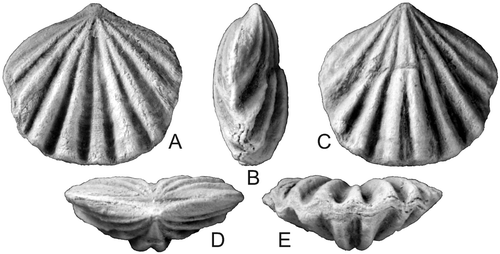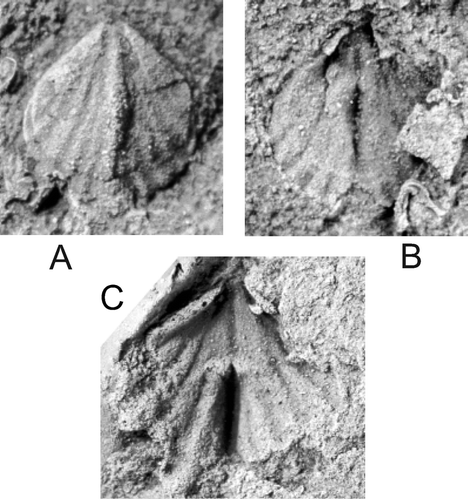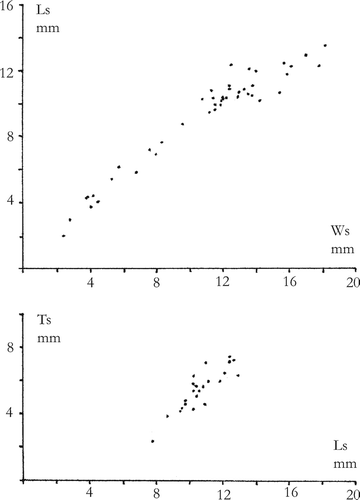Abstract
Ten atrypide taxa, belonging to the superfamilies Atrypoidea, Lissatrypoidea, and less certainly the Glassioidea, are described from the late Wenlock or earliest Ludlow to Přídolí of the Yass Syncline. New taxa are Gracianella (Gracianella) kausi yassensis subsp. nov. and Spirigerina mitchelli sp. nov. On the basis of more abundant material from the Molong district, it is concluded that Atrypoidea (Atrypoidea) angusta Mitchell & Dun, Citation1920 is synonymous with the type species Atrypoidea (A.) australis (Dun, Citation1904). The single Přídolí species is comparable to Lissatrypa lenticulata Philip, Citation1962 from the Lochkovian of Victoria and central New South Wales, here referred to Meifodia Williams, Citation1951.
JENKINS (Citation1879), the first to describe the Yass Silurian sequence, recorded the presence of the brachiopod Atrypa at several levels. The distribution of this genus was also noted by Mitchell (Citation1887), and more detail was provided in the careful account of Shearsby (Citation1912). However, the only descriptions are those of Mitchell & Dun (Citation1920), who described three species (only one new) assigned to Atrypa and two to their new genus Atrypoidea. Savage (Citation1974) reassigned the one new species of Atrypa to his new genus Reticulatrypa. Copper (Citation1977) revised Atrypoidea, placing Atrypella Kozłowski, Citation1929, in synonymy with it, and selected lectotypes of both Australian species. Strusz (Citation1984) discussed, but could not resolve, the relationship between these two species.
In this paper, the fourth in a series revising the Silurian brachiopods from the Yass Syncline, all the known atrypides are described. Ten taxa are recognised, including one new species and one new subspecies; of the ten, none is abundant, and three are very rare and of uncertain identity. The two New South Wales species assigned to Atrypoidea by Mitchell & Dun (Citation1920) were based on some specimens from Yass and more extensive material from the Molong district. The relationship between them is assessed using those collections, and it is concluded that they are members of one variable species. The occurrence of a lissatrypid in Přídolí beds has led to a re-evaluation of the Australian species previously assigned to Lissatrypa (and erroneously to Australina by Strusz, Citation1982b).
Four taxa occur in the probably late Wenlock Yass Formation: Atrypa (Atrypa) sp. cf. A. dzwinogrodensis Kozłowski, Citation1929 (also known from the Yarralumla Formation in Canberra, see Strusz Citation1984), Atrypina (Atrypina) sp. cf. A. latesinuata Rong & Yang in Rong et al., Citation1974 (a Llandovery species from southwestern China), Spirigerina mitchelli sp. nov. and Atrypoidea (Atrypoidea) australis (Dun, Citation1904). All range higher in the sequence (see ). A single well-preserved shell tentatively referred to G. (Gracianella) comes from an uncertain late Gorstian or earliest Ludfordian level. Confined to the Ludfordian are Reticulatrypa pulchra (Mitchell & Dun, Citation1920), Gracianella (Gracianella) kausi yassensis subsp. nov. (the nominate subspecies is from the late Wenlock of Canberra), G. (Sublepida)? sp., and gen. et sp. indet. cf. Becscia. There is only one species in the Přídolí, Meifodia? sp. cf. M. lenticulata (Philip, Citation1962), represented by rather poor specimens not easily distinguishable from specimens of this Lochkovian species from Victoria and central New South Wales.
Fig. 1. Chart showing the stratigraphic distribution of atrypide taxa in the Yass Syncline. Dashed lines represent intervals of non-occurrence (those extending from the bottom of the chart are of taxa also known from Wenlock levels in the Canberra-Yass region). Arrows indicate uncertainty in range, usually because of poorly located early collections. The single very poorly located specimen tentatively assigned to G. (Gracianella) is not shown. Symbols for members within formations are (in ascending order): OCS — O'Briens Creek Sandstone, CL — Cliftonwood Limestone, EL — Euralie Limestone, ECS — Excursion Creek Sandstone, GRL — Gums Road Limestone, TS — Tullerah Sandstone, BL — Bowspring Limestone, BS — Barrandella Shale, HL — Hume Limestone, YS — Yarwood Siltstone, RHM — Rainbow Hill Member.
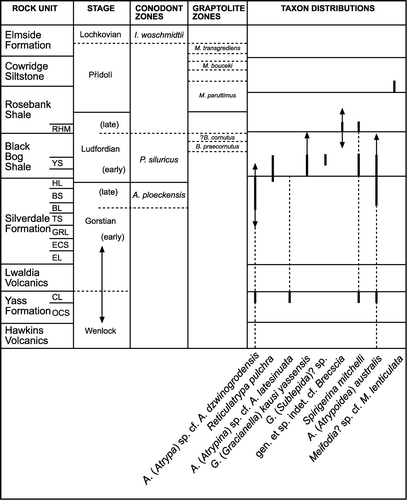
Biostratigraphy and correlation
A reasonably full account of the Yass succession and its correlation with the standard time-scale was given by Strusz (Citation2002), and that will not be repeated here. Of note is that the fossiliferous part of the total sequence (Yass Formation to Elmside Formation) was estimated by Link & Druce (Citation1972) to be 695 m near Silverdale, northwest of Yass, thicker in the centre of the syncline around Hattons Corner west of Yass, and thinner near its north and northwest margins. The section around Bowning in the northwest, while not well exposed, appears to be markedly thinner. The known ranges in the Yass sequence of the species described here are shown in .
Material and localities
Strusz (Citation2002) gave an account of the sources of material used in revising the Yass faunas, including an assessment of its reliability. Details of the localities, including possible benthic community assignments for each, were given in the Locality Appendix of Strusz (Citation2002), with additions by Strusz (Citation2003, Citation2005).
Systematic palaeontology
Classification
The classification adopted here is that in the revised Treatise on Invertebrate Paleontology, Part H, volume 3 (Kaesler Citation2002), as modified by Copper (Citation2004). References to authorship of genera, type species and suprageneric categories can be found in the former and are not unnecessarily repeated here.
Measurements and symbols
All linear measurements are in millimetres and, unless otherwise specified, are as defined by Williams et al. (in Kaesler Citation1997); angular divergence is measured in degrees between the diverging structures, not of one or other from the centre-line. The following symbols are used for linear measurements:
| • | Ls, Ws, Ts: maximum shell length, width, thickness; | ||||
| • | CM: width of cardinal margin in non-strophic shells; | ||||
| • | Lv, Ld: ventral and dorsal valve length; | ||||
| • | L(Wmax): length to widest part of shell; | ||||
| • | ADAC: absolute deflection of anterior commissure (Jones Citation1974, p. 965). | ||||
Repositories
The repositories for the specimens studied are indicated by the following prefixes to their catalogue numbers:
| • | AMF: Palaeontological collections, Australian Museum, Sydney. | ||||
| • | ANU: Geology Department, Australian National University, Canberra. | ||||
| • | CPC: Commonwealth Palaeontological Collection, Geoscience Australia, Canberra. | ||||
| • | MMF: Palaeontological collections, Geological Survey of New South Wales, Sydney. | ||||
Suborder ATRYPIDINA Moore, 1952
Superfamily ATRYPOIDEA Schuchert & LeVene, 1929
Family ATRYPIDAE Gill, 1871
Subfamily ATRYPINAE Waagen, 1883
Atrypa Dalman, 1828
Type species
Anomia reticularis Linnaeus, 1758. Ludlow, Gotland.
Remarks
Atrypa and its relatives have been the subject of much disagreement regarding the limits to be drawn between genera and species. In 1985, I set down my understanding of the genus, commenting on the need for a comprehensive revision of the atrypids from Gotland (Strusz Citation1985). Copper (Citation2004) achieved this, noting (p. 34) significant variability so that, at least for Silurian atrypids, ‘large numbers of specimens are required to identify and delineate species statistically’. Copper went into considerable detail on this variability, and noted (p. 35) ‘The delineation of species … in the Silurian is somewhat more difficult than for Devonian taxa ….’
When Mitchell & Dun (Citation1920) examined the Silurian atrypids of New South Wales, they had no such difficulty in ascribing their large globose specimens directly to Atrypa reticularis. Certainly, the available specimens are close to the type species in both morphology and age, but from our current understanding of that species, they are not conspecific. Unfortunately, material is not as abundant in the Yass sequence as a reading of Jenkins (Citation1879, p. 26) or Mitchell (Citation1887, pp. 1195, 1197) might suggest. Of the material used by Mitchell & Dun (Citation1920), 36 specimens are still accessible, but the locality information is poor. My collecting has added another 15 usable specimens, and I have found no localities where even fragmentary Atrypa is abundant. After considering the species revised by Copper from Britain and Gotland, I can see no reason to change my conclusion (Strusz Citation1984) that the morphologically closest taxon is one from Podolia, despite the considerable palaeogeographic separation.
Atrypa (Atrypa) sp. cf. A. dzwinogrodensis Kozłowski, Citation1929 ( – )
Fig. 2. Atrypa sp. cf. A. dzwinogrodensis Kozłowski, Citation1929. A, AMF29280, juvenile shell. B, AMF29279, clearly showing abrupt change in rib size and spacing. C, AMF29198, figured Mitchell & Dun Citation1920, pl. XV, . D, AMF29199, figured Mitchell & Dun, pl. XV, . A & B labelled ‘Silverdale’, Silverdale Fm or basal Black Bog Shale; C & D labelled ‘near Silverdale’, Bowspring Limestone Member. Letters d , l , v , p , a , here and in subsequent Figures, indicate the same shell in dorsal, lateral, ventral, posterior and anterior views. All ×2.

Fig. 3. Atrypa sp. cf. A. dzwinogrodensis Kozłowski, Citation1929. Plots of Ls and Ts Against Ws, and the ratio L(Wmax)/Ls against Ls.
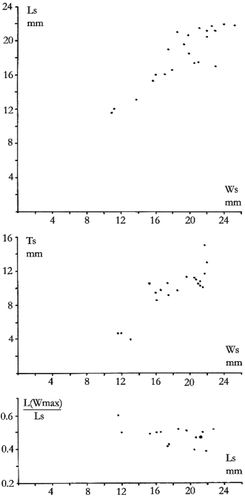
Fig. 4. Atrypa sp. cf. A. dzwinogrodensis Kozłowski, Citation1929. A, AMF29281, large shell with partly preserved marginal flange, figured Mitchell & Dun Citation1920, pl. XVI, . B, AMF129699, incomplete juvenile ventral internal mould. C, D, AMF28675, dorsal internal mould in dorsal and posterior views. A labelled ‘Silverdale’, B – D ‘Hattons Corner’, Silverdale Fm or basal Black Bog Shale. Letters d , l , v , p , a — dorsal, lateral, ventral, posterior, and anterior views. All ×2.
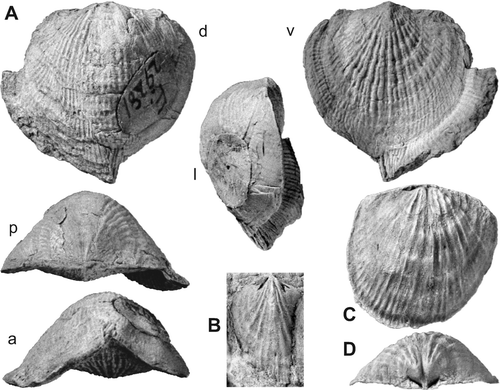
1920 Atrypa reticularis Linnaeus; Mitchell & Dun, (partim) p. 266 – 267, pl. XV, – , pl. XVI, , ; non pl. XV, – .
Fig. 5. Reticulatrypa pulchra (Mitchell & Dun, Citation1920). A, AMF29353, lectotype, figured by Mitchell & Dun (Citation1920, pl. XVI, , ). B, ANU46437, latex replica of ventral exterior. C, AMF29354, paralectotype, figured by Mitchell & Dun Citation1920, pl. XIV, ). D, E, AMF27790, ventral external mould showing rib structure. F, AMF29352, paralectotype, figured by Mitchell & Dun (Citation1920, pl. XVI, ). G, ANU46435, latex replica of juvenile dorsal interior. H, CPC38992, ventral internal mould. I, J, AMF25836, dorsal internal mould and latex replica. A, C, F labelled ‘Limestone Creek near Silverdale’, Hume Limestone Member or basal Black Bog Shale; B, loc. KC47, H, loc. GOU46, Yarwood Siltstone Member; D, E labelled ‘near Bowning’, probably basal Black Bog Shale; G, loc. KF, I, J labelled ‘Hattons Corner, LTB’, lower Black Bog Shale. Letters d , l , v , p , a — dorsal, lateral, ventral, posterior, and anterior views. A, C, D, F, H – J ×2, B, G ×4, E ×5.
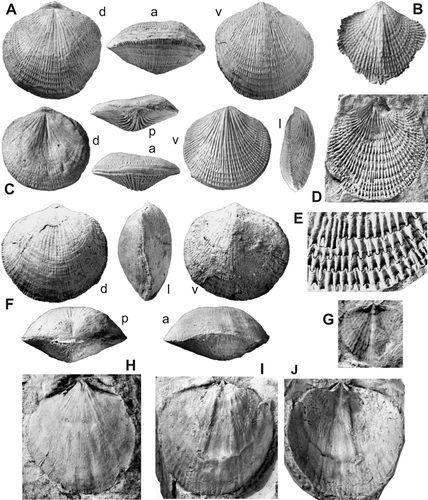
Fig. 6. Reticulatrypa pulchra (Mitchell & Dun, Citation1920). Plots of Ls and Ts against Ws, and the ratio L(Wmax)/Ls against Ls.
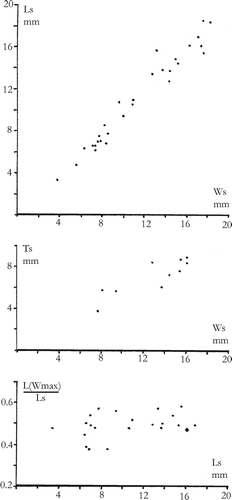
Fig. 7. Atrypina (Atrypina) sp. cf. A. latesinuata Rong & Yang, Citation1974. A, B, ANU46440, latex replicas of ventral and dorsal exteriors. C, ANU46444, latex replica of dorsal exterior. D, E, ANU46439, latex replicas of ventral exterior and interior. A – C loc. KE, D – E loc. KC48; Yarwood Siltstone Member. All ×8.
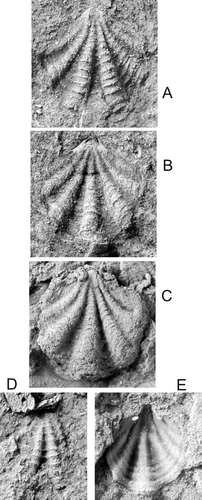
cf. 1929 Atrypa reticularis (Linné) var. dzwinogrodensis Kozłowski, p. 170 – 173, pl. VIII, – .
cf. 1954 Atrypa reticularis L. var. dzwinogrodensis Kozłowski; Nikiforova, p. 117 – 118, pl. XIII, – .
cf. 1970 Atrypa dzwinogrodensis Kozłowski, Citation1929; Rubel, p. 37 – 38, pl. XIX, – , pl. XX, , – , .
1984 Atrypa sp. cf. dzwinogrodensis Kozłowski, Citation1929; Strusz, p. 139 – 140, .
cf. 1985 Atrypa reticularis dzwinogrodensis Kozłowski, Citation1929; Nikiforova et al., p. 39, pl. 10, .
Material
Available material includes old and in many cases poorly located specimens from the Australian Museum and Geological Survey of New South Wales, plus well-located material held by Geoscience Australia. Some of the old specimens can be fairly reliably tied to particular beds, using the stratigraphic and geographic information from Jenkins (Citation1879), Mitchell (Citation1887), Shearsby (Citation1912), and Mitchell & Dun (Citation1920).
Yarralumla Formation, Canberra: CPC23908 – 23921 (this horizon is a lateral equivalent of the Yass Formation) — see Strusz (Citation1984). Yass Formation: CPC38982 – 4 plus numerous fragments from GOU48. Yass Formation or lower Silverdale Formation: CPC38985 – 8 plus several fragments from GOU51L, GOU51U (railway cutting west of Bowning). Bowspring Limestone: AMF29198 (Mitchell & Dun Citation1920, pl. XV, ), 29199 (Mitchell & Dun Citation1920, pl. XV, ), 129702 – 3 from GOU57 (junction of Limestone and Derrengullen Creeks). Barrandella Shale Member: CPC38979 – 80 plus several fragments from GOU2a, CPC38981 plus 1 fragment from GOU2b (Hattons Corner). Silverdale Formation or basal Black Bog Shale: AMF8304, 26429, 28674, 28675, 129695 – 9; MMF596 (Hattons Corner); AMF28618, 29278 (Mitchell & Dun Citation1920, pl. XVI, ), 29279, 29280, 29281 (Mitchell & Dun Citation1920, pl. XVI, ), 29282, 129700 – 1 (Silverdale). Horizon unknown: MMF589 – 591, 592A – B, 593 – 594, 597, 603?
Stratigraphic distribution
Yarralumla Formation and coeval Yass Formation to Silverdale Formation and possibly basal few metres of Black Bog Shale.
Age
Late Wenlock or early Gorstian to earliest Ludfordian.
Description
Shell medium-sized; for specimens from Yass, mean length 18.1 mm (maximum 22.0 mm), mean width 16.4 mm (maximum 25.3 mm). Outline rounded to slightly shield-shaped, in most cases slightly wider than long (Ls/Ws mean 0.96), with relatively wide almost straight cardinal margin (CM/Ws mean 0.67), usually obtusely rounded cardinal extremities; greatest width mostly about mid-length (mean 0.47Ls). Lateral profile thick, moderately to strongly dorsibiconvex, Ts/Ls mean 0.52 (max. 0.61); juvenile shells thinner, Ts/Ls increasing until Ls ca. 16 mm, then changing little with increasing size (see ). In adults, dorsal valve is 2 – 3 times thickness of ventral valve. Longitudinally, ventral valve convexity is low and even along mid-line, but dorsal valve most strongly convex in posterior half. Ventral beak sharp, apical angle about 125 – 135°, extends little beyond cardinal margin, adpressed over dorsal beak; transapical foramen and tiny deltidial plates in juveniles, foramen persists in some adult shells. Ventral umbo with raised median pair of primary ribs, usually separated by very fine intercalated rib; in some, median ribs start as single rib, which divides within 2 mm of apex. Broad rounded sulcus anteriorly, rarely extending as short tongue. Dorsal beak very low; umbonal region with marked narrow sulcus, replaced anteriorly by well-developed but not strongly delineated fold. Anterior commissure broadly and commonly strongly uniplicate.
Ribs rounded, fairly strong, coarser medially than laterally, wider than furrows. Rib increase by both splitting and intercalation, and episodic so that rib size is somewhat variable, with noticeable episode towards mid-length; between 5 and 8 ribs in 5 mm at anterior margin. Ribs interrupted by (and commonly increase at) fairly regular growth lamellae, crowded towards margin in adult shells; intersections appear slightly nodular in worn shells. In well-preserved shells, lamellae rise from valve surface at about 40°, and up to 2 mm long. Outermost lamella on ventral valve, and in some cases one or two before it, can be preserved as frills up to 8 mm wide; marginal frills are approximately parallel to dorsal valve surface (see ), may be convex. Low ribs continue across frill.
Shell relatively thin. Internal details not well known. Teeth large but not swollen. Dental cavities slit-like in juveniles, can persist in adults but then are very narrow. Ventral muscle field subtriangular, weakly to moderately impressed. Sockets fairly prominent, diverge at 110 – 120°, with prominent inner socket ridges rolled over sockets; low middle socket ridges; prominent transverse corrugations. Cardinal pit wide, shallow; in some specimens, cardinal process visible as small longitudinally striated apical pad. Notothyrial platform triangular, prolonged forward as strong tapering myophragm dividing striated semioval to slightly cordate dorsal adductor field. One internal mould shows this myophragm dividing at about 1/4 valve length, diverging and then recurving around front of muscle field.
Comparison
The Yass species is similar to the Gotland type species Atrypa (Atrypa) reticularis, differing in smaller size, more rounded outline with maximum width farther forward, stronger fold and sulcus, accentuated ventral median rib-pair posteriorly, thinner shell, and a less flattened ventral valve (, ). Internally, it has less well-differentiated muscle fields. As noted by Strusz (Citation1984), the Podolian Přídolí species A. (A.) dzwinogrodensis is very close to the local form. It differs in being more commonly shield-shaped (although Kozłowski's figured specimens show considerable variation in outline), with a shallower ventral valve. Adult shells were reported to lack a foramen. The ribs are somewhat stronger, and do not show so clearly a dramatic increase in number (with concomitant decrease in average size) near mid-length; the accentuated ventral median rib-pair is present, however, as is the marked dorsal umbonal sulcus (which appears to be the external reflection of a strong myophragm). Rubel's (Citation1970) specimens from the Wenlock Jaagarahu horizon are closer to the Yass form, and do retain the foramen in adults; Nikiforova et al. (Citation1985) implied that they could be specifically distinct from the Podolian species.
Atrypa (Atrypa) lazutkini Alekseyeva, Citation1960 (see Alekseyeva Citation1962, Gratsianova Citation1967) from the Ludlovian to Lochkovian of the Kuznetsk Basin, Salair and Gorny Altai is also similar, with a closely comparable rib pattern, but the cardinal margin is recurved laterally, the ventral umbo is relatively more convex than the remainder of the valve, the anterior sulcus is narrower and more sharply defined, and the marginal frills are much wider.
Of the British species (revised by Copper Citation2004), A. (Atrypa) murchisoni Alexander, Citation1949, from the early Ludfordian lower Elton Formation of Britain is approximately coeval and quite similar. It is on average a little smaller, but has a similar shape and rib pattern [like A. (A.) dzwinogrodensis, the change in average rib size towards mid-length is not so marked]. It differs in having a relatively more inflated ventral umbo, closer growth lamellae, shorter marginal frills, and a narrower, more clearly defined anterior fold and sulcus, which tends to be more rectangular in cross-section. The older species A. (Atrypa) harknessi Alexander, Citation1949, probably from the Sheinwoodian upper Coalbrookdale Formation, is also similar in shape and rib pattern but is more obviously shield-shaped, has a more prominent ventral beak but weaker fold and sulcus, and tends to be smaller and somewhat elongate; the frill is more strongly ribbed. The stratigraphically intermediate species A. (Atrypa) lapworthi Alexander, Citation1949, from the topmost Much Wenlock Limestone or basal Elton Formation, is also very similar in overall appearance, but can be much larger, its ribs much more even and less strongly interrupted by growth lamellae; the fold and sulcus are much weaker.
The closest North American species is A. (Atrypa) oklahomensis Amsden, Citation1958, from the Lochkovian Haragan Formation. This species can reach a larger size, and is distinguished by its more sharply defined sulcus, finer but sharper ribs with less marked change in size around mid-length. The Ludlow species A. (A.) tennesseensis Amsden, Citation1949, while similar in size, shape, and rib spacing, has a much weaker fold and sulcus, stronger ribs, and closer growth lamellae.
Closer to Yass, Atrypa duntroonensis Mitchell & Dun, Citation1920 is represented by poorly preserved and tectonically distorted specimens from the Canberra Formation. To judge from the brief description and illustrated specimens, plus what little material has been collected from the type locality and is now in the Geoscience Australia collections, it is somewhat smaller, generally more elongate, subequally biconvex, with weak anterior fold and sulcus, finer ribs, crowded growth lines or lamellae. No frills have been preserved, but preservation is too poor for this to be significant. It is likely to prove an unusable species. Although difficult to compare because of their generally distorted preservation, the Canberra Formation Atrypa compared by me (Strusz Citation1985) with Spinatrypa perflabellata Talent, Citation1963, is of similar size and ribbing, including the slightly accentuated ventral median pair with intervening fine rib, and shows the same change in rib size and density at about mid-length as the Yass species. However, the former can be easily distinguished by a more elongate outline, less strongly dorsibiconvex profile, and gently uniplicate anterior commissure (there is no detectable sulcus).
The Lochkovian Victorian atrypids compared with A. (A.) reticularis by Philip (Citation1962) differ from both the Gotland and Yass species in having a significantly more convex ventral valve, and less prominent growth lamellae. Atrypa thomsonensis Talent, Citation1956, also Lochkovian, is also subequally biconvex, and has much finer ribs (about 18 in 5 mm).
Subfamily ATYRYPINELLINAE Copper in Kaesler Citation2002
Reticulatrypa Savage Citation1970
Type species
Reticulatrypa fairhillensis Savage, Citation1970; Lochkovian, New South Wales.
Remarks
Copper (p. 1438 in Kaesler Citation2002) placed the Subfamily Atrypinellinae within the Punctatrypoidea but expressed doubts over the position of all the included genera except Atrypinella itself. Copper (Citation2004, p. 72) unequivocally placed the subfamily within the Atrypidae, and was uncertain whether Reticulatrypa should be regarded ‘as a member of the Atrypinellinae or whether it is a side branch of the Atrypinae ….’ The Yass material can add little to addressing the dilemma, so I follow Copper's more recent position in this paper.
Reticulatrypa pulchra (Mitchell & Dun, Citation1920) ( – )
1920 Atrypa pulchra Mitchell & Dun, p. 270, pl. XIV, , pl. XVI, – .
Type specimens
AMF29352 (Mitchell & Dun Citation1920, pl. XVI, ), AMF29353 (Mitchell & Dun Citation1920, pl. XVI, , ), AMF29354 (Mitchell & Dun Citation1920, pl. XIV, ). Limestone Creek, ‘Silverdale’. I here select AMF29353 as lectotype, the other two figured specimens thus being paralectotypes.
Type horizon
Stated by Mitchell & Dun (Citation1920) to be ‘the upper of the limestone beds of Limestone Creek, Silverdale, immediately below the Lower Trilobite Beds of the Bowning Series ….’ This is either the Hume Limestone Member, or the immediately overlying relatively fossiliferous siltstone at the very base of the Black Bog Shale.
Other material. Topotypes
AMF129704 – 129712 (Mitchell collection, and probably used in the original description), AMF37798 (Mitchell collection). Lower Black Bog Shale: near Bowning — AMF28647 (Mitchell collection, labelled ‘LTB’, i.e. ‘Lower Trilobite Bed’), probably also AMF27790 (Mitchell collection), and MMF599 (collected Ranft 1901); KC — ANU9723 – 4, 15625, 46436 – 8; KF (=GOU52) — CPC38998 – 39000, ANU46435; Hattons Corner (probable) — AMF25836 (Mitchell collection). Yarwood Siltstone: GOU28 — CPC38989 plus two others; GOU46 (=KE) — CPC38990 – 7 plus 10 others, ANU9725, 46434.
Distribution
Possibly Hume Limestone Member, certainly lower Black Bog Shale and Yarwood Siltstone Member, Yass Syncline.
Age
Early Ludfordian, Polygnathus siluricus Zone.
Diagnosis
Medium-sized species of Reticulatrypa with subcircular outline, posteriorly carinate ventral valve, weak or no deflection of anterior commissure, and ribs distinctly coarser in near-umbonal regions than marginally.
Description
Shell medium-sized (max. length and width c. 19 mm), biconvex with valves of approximately equal thickness, lenticular (Ts/Ls mean 0.54; ). Outline subcircular (Ls/Ws mean 0.96, mode 0.85 – 1.05), maximum width about midlength (Lwmax/Ls mean 0.48, mode 0.45 – 0.55; ). Ventral beak broad, prominent, upright, apical angle about 130°. Area curved, weakly apsacline to weakly anacline, and fairly broad — cardinal margin gently curved, and about 2/3 shell width (mean 0.70, mode 0.6 – 0.75), widest in juveniles. Cardinal extremities obtuse, somewhat rounded. Delthyrium wide, with usually prominent oval apical foramen between narrow deltidial plates. Dorsal beak very low. Ventral valve broadly to strongly carinate especially posteriorly, flanks mostly flat, fold narrowly rounded posteriorly, broadening and fading anteriorly. Dorsal valve with distinct narrow sulcus posteriorly, also widening and fading anteriorly, usually becoming indiscernible beyond 2/3 shell length. Anterior commissure weakly unisulcate in juveniles, becoming rectimarginate to broadly and gently uniplicate in adults. Both valves with thin shell.
Ribs fine, strong, rounded, separated by narrower furrows, crossed over most of shell by strong growth lamellae (), which form short frills (1 mm or less, see ). Posterior 6 – 9 mm of shell with relatively coarser ribs and coarse growth lines but no lamellae (). At edges of lamellae, inter-rib furrows extend as short blunt spines. In worn shells, intersection of ribs and lamellae nodose. Ribs increase by both intercalation and splitting, usually at growth lamellae, increase more frequent from about 6 – 8 mm so that posterolateral ribs increasingly curved towards margins. Rib spacing, therefore, very variable, from 8 to over 20 in 5 mm marginally but is mostly between 13 and 18 in 5 mm.
Ventral interior with narrow very divergent teeth supported on thin, widely divergent dental plates, leaving deep slit-like dental cavities. Muscle field elongate triangular and moderately impressed in juveniles (particularly posteriorly), becoming subtriangular to flabellate and only weakly impressed in adults. Short posterior myophragm developed.
Dorsal interior poorly known (). Sockets delicate, narrow, widely divergent, corrugated. Notothyrial platform developed. Spiralia and cardinal process unknown.
Comparison
Only three species are of comparable size, most others having maximum lengths between 6 and 12 mm. Reticulatrypa ryanensis Boucot, Johnson & Zhang, Citation1988, from the Wenlock of California, is of similar outline and transverse profile, but differs in being a little smaller, with generally coarser, more evenly sized ribs, and a distinct reversal on the ventral valve from carinate posterior to sulcate anterior. Reticulatrypa hamrae Copper, Citation2004, from the Ludlow of Gotland, is also similar in outline, but the ventral valve is not carinate, the ribs are coarser and more even in size, and are strongly interrupted by evenly spaced growth lamellae even on the umbones. Reticulatrypa losvensis (Khodalevich, Citation1951), as illustrated by Tyazheva & Zhavoronkova Citation1972 from the Lochkovian of the eastern Urals, is easily differentiated by being transverse oval (Ls/Ws <0.8), thicker, non-carinate, with coarser, evenly sized ribs.
Of Australian species, the Lochkovian type species R. fairhillensis Savage, Citation1970, is generally similar in shape and appearance but smaller (Ls mostly <10 mm); it differs also in being mostly more transverse and thicker, and in having generally fewer and more subdued growth lamellae. Neither Savage (Citation1970) nor Farrell (Citation1992) reported or figured specimens with spines arising from the inter-rib furrows where they meet the growth lamellae. Reticulatrypa chattertoni Lenz & Johnson, Citation1985, from the Pragian of NSW, is similar in having ribs strongly differentiated in size between umbo and margin, but is much smaller (Ls 5 – 6 mm), wider (Ls/Ws <0.8), with a subtriangular to semi-oval outline, and a weakly carinate ventral valve.
Family ATRYPINIDAE McEwan, 1939
Subfamily ATRYPININAE McEwan, 1939
Atrypina Hall in Hall & Clarke, 1893
Type species
Leptocoelia imbricata Hall, 1859; ?Pragian – Emsian, New York.
Subgenus Atrypina Hall in Hall & Clarke, 1893
Atrypina (Atrypina) sp. cf. A. latesinuata Rong & Yang, Citation1974 ( – )
Fig. 8. Atrypina (Atrypina) sp. cf. A. latesinuata Rong & Yang, Citation1974. Plot of Ls against Ws, including (crosses) data for A. (A.) latesinuata from Rong & Yang Citation1981.
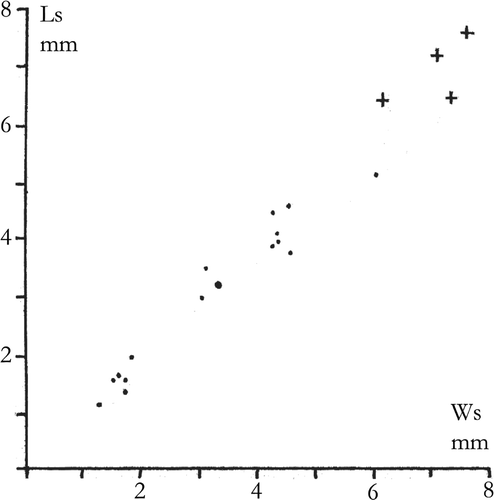
cf. 1974 Atrypina latesinuata Rong & Yang in Rong, Xu & Yang, p. 200, 93 (7 – 8).
cf. 1981 Atrypina (Atrypina) latesinuata; Rong & Yang, pp. 231 – 232, XIX (27 – 39), XXII (18).
Material
Cliftonwood Limestone, Yass Formation: GOU48 — CPC39010. Lower Black Bog Shale: GOU4 — CPC39001; KF (=GOU52) — CPC39011 plus 3 others, ANU46535. Yarwood Siltstone Member, Black Bog Shale: KC — ANU46439; KE (=GOU46) — CPC39003 – 39009 plus 21 others, ANU9562, 46440 – 46444; probably MMF17711.
Distribution
Yass Formation (rare), Black Bog Shale up to Yarwood Siltstone Member.
Age
Late Wenlock or early Gorstian to early Ludfordian.
Description
Shell minute to small (largest specimen 5.1 mm long, 6 mm wide, mean Ls 3.08 mm, mean Ws 3.07), planoconvex to slightly ventribiconvex, lenticular, with even longitudinal curvature. Outline subcircular to subpentagonal, with width about the same as length (mean Ls/Ws 0.98), and greatest width about mid-length. Ventral valve moderately convex, transverse profile commonly subcarinate, with prominent fold and generally flat flanks. Dorsal valve more or less flat, with wide shallow sulcus (). Anterior commissure rectimarginate to plicosulcate. Cardinal margin about 2/3 width, moderately curved, with rounded extremities. Ventral beak wide, fairly prominent, apical angle 100 – 125°; area orthocline, divided by large oval foramen, which commonly truncates beak, and is flanked by triangular deltidial plates. Dorsal beak low, very broad.
Ventral valve with 6 or 8 strong rounded ribs, decreasing in size and increasing in curvature laterally (); fold formed by prominent pair of elevated, gently curved ribs; in some cases an additional pair of small, low ribs posterolaterally. Dorsal valve with 5 or 7 similar ribs; sulcus defined by coarse curved ribs, contains prominent but lower median rib starting between umbo and mid-length. Furrows narrower than ribs, and nearly flat-bottomed. Growth lamellae well developed, evenly spaced (c. 0.3 mm), becoming a little more crowded near margin in larger shells.
Teeth small, narrow, supported by thin widely divergent dental plates; dental cavities slit-like. Muscle field weakly impressed, bilobed, divided posteriorly by small myophragm. Dorsal interior, cardinalia, and spiralia not known.
Remarks
The single small (Ws 2.5 mm) gently convex dorsal valve from the Yass Formation differs from the others in having relatively subdued growth lamellae, and nine ribs on the dorsal valve, including two pairs of weak ribs branching inwards from those defining the sulcus, the first pair at about 1/3 valve length, the second pair close to the margin. A matching pattern is, however, seen on one tiny ventral valve from locality KE, so the older specimen is almost certainly conspecific.
Comparison
The Yass form is very close morphologically to the Aeronian — Telychian species Atrypina (A.) latesinuata from the Xiangshuyuan and Leijiatun Formations of southwest China, as illustrated by Rong & Yang (Citation1981). The Chinese species reaches a larger size (Ws to 7.7 mm), and differs in having straight rather than curved ribs. The Wenlock species A. (A.) disparilis (Hall, Citation1852) from Indiana and Utah (Sheehan Citation1976) is more elongate, and adult shells have a strongly convex longitudinal profile with greatest convexity anterior. Its growth lamellae are more sparse and subdued, the dorsal midrib less prominent and inserted further from the beak. A. (A.) buildwasensis Copper, Citation2004, from the Wenlock Coalbrookdale Formation of Britain, is also a little larger and more elongate, tends to be more obviously subpentagonal, and has a greater number of straight ribs; the median pair defining the ventral fold are more strongly enlarged. Also similar is A. (A.) inops Havlíček in Havlíček & Štorch (Citation1990), from the Ludlow Kopanina Formation of the Prague Basin. It differs in more subdued growth lamellae, straight ribs, and narrower inter-rib furrows.
Atrypina (Atrypina) talenti Savage, Citation1970, from the Lochkovian Berkley Formation and Lochkovian – Pragian Garra Formation of New South Wales, is clearly distinguished from the Yass form by its smaller maximum size, elongate outline, sharper ventral beak, ventribiconvex and relatively thick profile, and subdued growth lamellae only developed marginally.
Gracianella Johnson & Boucot, Citation1967
Type species
Gracianella lissumbra Johnson & Boucot, Citation1967.
Subgenus Gracianella Johnson & Boucot, Citation1967
Gracianella (Gracianella) kausi (Strusz, Citation1982)
1982 Australina (Australina) kausi Strusz, pp. 123 – 126. Citation1982a
1982 Australina (Australina) n. sp. Strusz, p. 74, . Citation1982b
1988 Gracianella kausi; Boucot, Johnson & Zhang, p. 119.
Remarks
Copper (Citation1986, p. 855) suggested that this species did not belong in Australina, and tentatively assigned it to Glassia Davidson, 1881. In their revision of Australina, Copper et al. (Citation1988, p. 534) indicated assignment to Gracianella, and this was more formally stated by Boucot et al. (Citation1988, p. 119). I concur with this assignment based on the additional morphological information provided by Copper (Citation1986) and Copper et al. (Citation1988).
Gracianella (Gracianella) kausi lacks ribs, and is relatively large for the genus. It differs from the Ludlow type species G. (G.) lissumbra not only in size, but in outline (the maximum width is not as far forward), and in stronger internal structures (median ridge, cella) in the ventral valve. Both have a tendency towards geniculation of the margin in large shells, but it is more extreme in G. (G.) kausi (compare Johnson & Boucot Citation1967, pl. 109, fig. 36 with Strusz Citation1982a, figs 19A2, C1). Gracianella (Gracianella) clarula (Havlíček, Citation1987) from the Ludlow of the Prague Basin is much more transverse, lenticular, with a low ventral beak, less well-developed fold and sulcus, and a low ventral muscle platform.
The Czech Přídolí species G. (G.) evanisca Havlíček & Štorch, Citation1990 and G. (G.) graciosa Havlíček & Štorch, Citation1990 are possibly synonymous and weakly ribbed or in some cases smooth. Both resemble G. (G.) kausi in outline, tending to be somewhat transverse (Ls/Ws 0.83 – 1.04 and 0.82 – 1.00, respectively); the former reaches a maximum width of 7.6 mm, the latter 6.5 mm. Smooth G. (G.) evanisca shells differ from G. (G.) kausi in their poorly differentiated fold and sulcus, smooth G. (G.) graciosa have a narrower sulcus, and the cella is more posteriorly placed.
Gracianella (Gracianella) kausi yassensis subsp. nov. ( – )
Fig. 9. A – D, Gracianella (Gracianella) kausi kausi (Strusz, Citation1982). A, B, CPC20518, holotype, in dorsal and ventral views. C, CPC20473, paratype, latex replica of ventral interior. D, CPC20475, paratype, latex replica of dorsal interior. Walker Volcanics, Canberra. E – O, Gracianella (Gracianella) kausi yassensis n.ssp. E, ANU15607, paratype, latex replica of ventral interior. F, G, ANU 15606, holotype, latex replica of ventral interior in dorsal and oblique views. H, I, ANU46449, paratype, latex replicas of dorsal exterior and interior. J, ANU46454, paratype, latex replica of dorsal interior. K, ANU46446, paratype, latex replica of dorsal exterior. L, ANU15603, paratype, latex replica of dorsal interior. E – L, loc. KC, Yarwood Siltstone Member. M, CPC39015, dorsal internal mould. N, ANU46459, latex replica of ventral interior. O, ANU46462, latex replica of dorsal interior. M – O, loc. KF (GOU52), lower Black Bog Shale. All ×8.
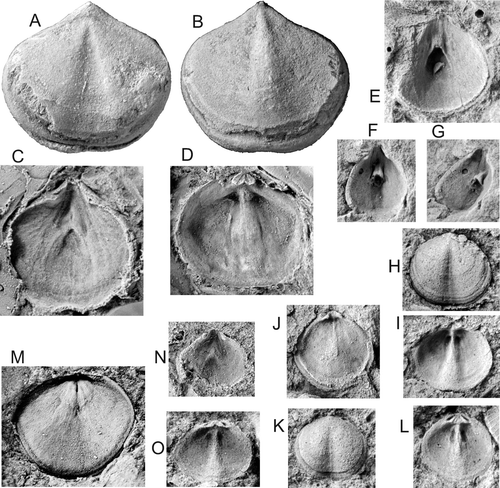
Fig. 10. Gracianella (Gracianella) kausi (Strusz, Citation1982). Plots of Ls and Ld against Ws for subspecies kausi (dots) and yassensis (crosses).
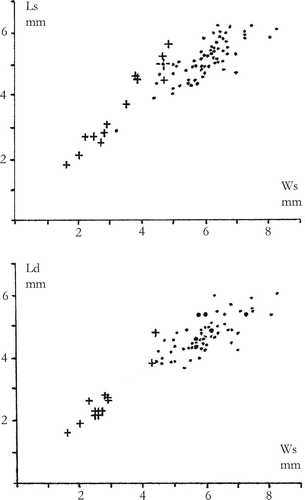
Type material
Holotype ANU15606 (KC20 – 39), paratypes ANU15602, 15603, 15605, 15607, 15612, 46445 – 46456, all from general locality KC.
Other material
KE — ANU46457; KF — ANU46458 – 46463.
Distribution
Lower Black Bog Shale including Yarwood Siltstone Member.
Age
Early Ludfordian, Polygnathus siluricus Zone.
Diagnosis
Subspecies of Gracianella (Gracianella) kausi differing from other representatives of the species in its smaller size, more elongate outline, more convex ventral valve, less clearly defined fold and sulcus, less massive thickening of dorsal valve below hinge plates, deeper cella in ventral valve.
Description
Shell ventribiconvex, dorsal valve gently convex, ventral strongly convex tending to carinate; no geniculation in larger shells. Outline subcircular, ventral beak broad, erect, truncated by apical foramen, dorsal umbo very low, wide. Maximum length 5.8 mm, width 4.5 mm; Ls/Ws 0.93 – 1.08; greatest width about mid-length. Delthyrium large; deltidial plates not seen. Ventral fold weakly developed, dorsal sulcus wide, posteriorly obscure, moderately deep anteriorly, with low, narrow median rib; margins not well defined. Anterior commissure broadly sulcate. Shell surface smooth, with weak concentric growth lines, one near margin commonly pronounced.
Teeth small, triangular, divergent, supported by thickening of valve wall. Delthyrial cavity deep, with wide myophragm supporting narrow parallel adductor scars, and separating impressed elongate subtriangular diductor scars whose mid-length is level with teeth. Front of myophragm moderately to very strongly raised at about 1/3Ls, concave, extending anterolaterally as distinct ridges surrounding well-developed triangular cella, which extends to about 2/3Ls. Lateral and anterior margins thickened to form distinct shelf.
Cardinalia supported on moderately thickened posterior valve margin. Sockets narrow, deep, divergent at about 100°, with transversely corrugated floors; outer socket ridges slightly raised, inner socket ridges more prominent, separated distally by very narrow outer hinge plates from ridge-like crural bases. Inner hinge plates concave, may be fused medially but more typically are separated over most of their length by narrow cleft. Inner edges of hinge plates rest on prominent notothyrial platform, which extends forward as narrow median ridge, widening to merge with internal expression of wide sulcus at about mid-length. Ridge flanked by elongate oval, slightly divergent, somewhat impressed adductor scars extending from 1/4Ls to mid-length. No obvious cardinal process, diductors presumably attached to notothyrial platform between hinge plates. Spiralia and crura unknown.
Remarks
At first glance, the Yass specimens (), mostly preserved as moulds of detached valves, are simply smaller versions of the older Canberra subspecies (). However, plots of Ls and Ld against Ws () show that the Yass specimens are more elongate, with a noticeably different growth trend (there are insufficient specimens for rigorous statistical treatment). They also appear to have more convex, almost carinate, ventral valves, which probably lack the distinct narrow posterior carina of the Canberra form. Among the Canberra specimens, there is a vague hint of a rib in the sulcus of CPC20519 (Strusz Citation1982a, 1), but nothing as distinct as the fine median rib in all but one of the Yass specimens. Internally, the Yass form has a deeper, relatively larger, somewhat more posteriorly placed and more triangular cella flanked posterolaterally by distinct ridges. The thickening of the valve margin supporting the cardinalia is less massive, and the hinge plates tend to be smaller and narrower. However, there is overlap in all these characters, which leads me to separate the two forms at subspecies level. Gracianella (Gracianella) kausi yassensis differs from the other smooth forms (see above) in its subcircular outline, more convex and totally smooth ventral valve, and strongly developed ventral internal structures.
Gracianella (Gracianella)? sp. ()
Material
AMF131514 from Hattons Corner, near Yass.
Distribution
An unknown level within the interval from the Barrandella Shale Member to the basal Black Bog Shale.
Age
Late Gorstian or earliest Ludfordian.
Description
Shell small, transversely subpentagonal in outline, moderately ventribiconvex in profile, coarsely ribbed (); Ls 4.9 mm, Ws 5.4 mm, Ts 2.2 mm. Ventral beak nearly straight, low, wide; dorsal beak very low. Ventral valve moderately carinate in transverse profile, flanks gently convex, fold formed by prominent rounded mid-rib, which bifurcates at about 0.2Ls, forming deep narrow furrow from mid-length, which is occupied from about 2/3Ls by low, narrow, intercalated mid-rib. Prominent secondary ribs diverge from outer sides of fold close to umbo. Three primary ribs on flanks, the outermost relatively subdued. Weak tertiary ribs split from outer side of median rib-pair near anterior margin. Dorsal valve with wide, shallow, poorly defined sulcus containing five prominent ribs: two primary ribs at its outer limits, two secondary ribs diverging inwards from those near the umbo, and a slightly less prominent intercalated mid-rib (). Three ribs on each flank, the outermost very subdued. Commissure almost rectimarginate. Ventral area wide, about 1/3Ws, and low, largely occupied by delthyrium whose details are obscured by sediment; small apical foramen (). Internal structures unknown.
Remarks
This single shell was initially considered to be a neanic Spirigerina mitchelli sp. nov. because of its strong ribs and subpentagonal outline, but the ribbing pattern is quite different (compare with — a shell 7.5 mm long), and the sulcus is dorsal, not ventral. Plectatrypines and Anazygidines have similar ribbing, but the former have well-developed growth lamellae and ventral sulci, whereas the latter are punctate. The combination of rib pattern and dorsal sulcus is also found in Gracianella, but the subpentagonal outline is unusual. Nevertheless, in the absence of internal details the subgenus G. (Gracianella) seems the most likely home for this single well-preserved specimen. It differs from G. (Sublepida) in its complete lack of growth lamellae.
Subpentagonal outline aside, the Yass specimen most closely resembles G. (G.) plicumbra Johnson & Boucot, Citation1967, from the Ludlow of Nevada. That species has a similar rib pattern, including the development in some specimens of a fine intercalated mid-rib on a bifid carinate ventral fold, but has more and finer ribs, and is subcircular in outline with a more prominent ventral beak. All other species have lower, more rounded and finer ribs.
Subgenus Sublepida Mizens & Sapel'nikov, Citation1982
Type species
Terebratula sublepida de Verneuil, 1845; Přídolí, Ural Mountains.
Gracianella (Sublepida)? sp. ()
Material
ANU46464, 46465 from KE.
Distribution
Yarwood Siltstone Member, Black Bog Shale.
Age
Early Ludfordian, P. siluricus Zone.
Description
The available material consists of moulds of two ventral valves (). Shell small (Lv 3.4 mm), outline posteriorly triangular, anterolaterally evenly rounded. Length and width about equal. Ventral valve carinate, with prominent mid-rib flanked by 5 – 6 lower ribs that curve gently away from mid-rib. Ribs intersected near valve margins by 1 – 2 distinct growth lamellae, but otherwise no growth lines or lamellae visible. Beak upright, truncated by foramen, beak angle about 90°; area flat, orthocline, largely occupied by open delthyrium, possibly with narrow deltidial plates. Teeth elongate, divergent, appear to be supported only by valve wall. Muscle field cordate, on raised platform, which falls abruptly at mid-length to deep median furrow, reflecting external mid-rib; muscle field divided by shallow median furrow, which is constricted at anterior end of field; individual muscle scars obscure. Dorsal valve unknown.
Remarks
The material is too limited for confident generic identification, but the single ventral mid-rib precludes assignment to anoplotheciids or the spirigerine Ogilviella (which has a fairly similar ventral interior — Copper, fig. 971.1f in Kaesler Citation2002), and its prominence precludes affiliation with the clintonellines. The ventral exterior, apart from the sparse growth lamellae, is very much like that of the lectotype of the type species G. (S.) sublepida (Copper, fig. 963.4d – e in Kaesler Citation2002) from the Přídolí of the Urals. The ventral interior differs from the sections illustrated by Mizens & Sapel'nikov (Citation1982, B) in having a median furrow, rather than a low ridge, dividing the muscle field. The Urals specimens are larger than those from Yass.
Becscia Copper, Citation1995
Type species
Becscia scissura Copper, Citation1995. Llandovery, Anticosti Island, Canada.
Remarks
Current research on the atrypoid faunas of Anticosti Island has suggested that this genus is not a septatrypid, but an atrypinid close and perhaps ancestral to Atrypina (Copper, pers. comm. March, 2006).
gen. et sp. indet. cf. Becscia ()
Material
AMF129835, Mitchell Collection, ‘Bowning’, probably from the Rainbow Hill Member.
Age
Late Ludfordian.
Discussion
The material consists of a single, small, distorted, ventral internal mould (). The outline is oval, the profile convex, the surface probably smooth. There is a narrow median sulcus, and two prominent plications diverging from the umbo at about 30°. The beak is small, sharp, upright; area very small, almost entirely occupied by an open delthyrium. Teeth are small, widely divergent, buttressed by the valve walls; no dental cavities or plates. A narrow median ridge on the valve floor extends to about mid-length. Muscle field obscure.
This form is distinctive among smooth Silurian atrypides because of the prominent diverging plications. The Ordovician cyclospirids also have such a pair of ventral plications, but have dental cavities. The smooth-shelled probable atrypinid Becscia is externally very similar, but has long dental cavities. The dental cavities are smaller in the strongly ribbed Atrypina (sensu lato), absent in some Gracianella (sensu lato), which is moderately ribbed to smooth. Also smooth, and with only minute dental cavities, is Glassia Davidson, 1881. The shell is commonly ligate, somewhat suggestive of the marginal effect of the two ribs in the Yass shell, but has a rounded outline with a much broader incurved beak. In the absence of dorsal valve details, identification is tenuous and even the family position very uncertain. Despite its well-developed dental cavities, Becscia seems closer to the Yass specimen than Glassia.
Subfamily SPIRIGERININAE Rzhonsnitskaya, 1974
Spirigerina D'Orbigny, 1847
Type species
Terebratula marginalis Dalman, 1828.
Spirigerina mitchelli sp. nov. ( – )
Fig. 14. Spirigerina mitchelli sp. nov. A, B, AMF28570, ventral internal mould and latex replica. C, CPC39028, partly silicified shell in dorsal view. D, paratype AMF129717, juvenile shell. E, paratype AMF29173, figured by Mitchell & Dun (Citation1920, pl. XVI, ). F, paratype AMF29171, figured Mitchell & Dun pl. XVI, . G, holotype AMF51717, figured by Mitchell & Dun (Citation1920, pl. XVI, ). H, paratype AMF51716, figured by Mitchell & Dun (Citation1920, pl. XVI, ). I, paratype AMF29172, figured by Mitchell & Dun (Citation1920, pl. XV, ). J, paratype AMF29174, figured by Mitchell & Dun (Citation1920, pl. XVI, ). K, ANU46466, latex replica of ventral interior. L – N, ANU9720, latex replica of ventral interior in dorsal and anterodorsal views. A, B labelled ‘Bowning’, horizon uncertain; C, loc. GOU48, Yass Fm; D – J labelled ‘Limestone Creek, east of Bowning’ lower Black Bog Shale; K – N, loc. KC48, Yarwood Siltstone Member. Letters d , l , v , p , a —dorsal, lateral, ventral, posterior, and anterior views. A – J, L ×2, K, M, N ×4.
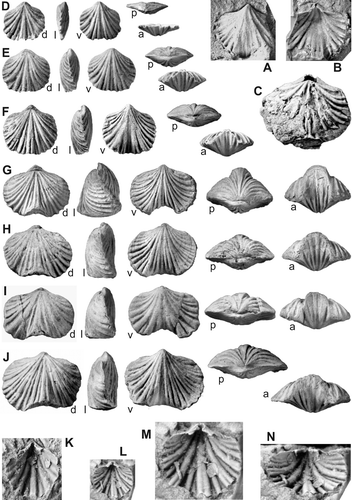
1920 Atrypa marginalis Dalman; Mitchell & Dun, p. 268 – 270, pl. XV, – , pl. XVI, – , text-figs – .
Fig. 16. Atrypoidea (Atrypoidea) australis (Dun, Citation1904). A, MMF4014, lectotype, Molong (shell not whitened). B, AMF29197, lectotype of Atrypoidea angusta Mitchell & Dun, Citation1920, labelled ‘Gurnett's’, Yass district (locality and horizon unknown). Letters d , l , v , p , a — dorsal, lateral, ventral, posterior, and anterior views. Both ×1.5.
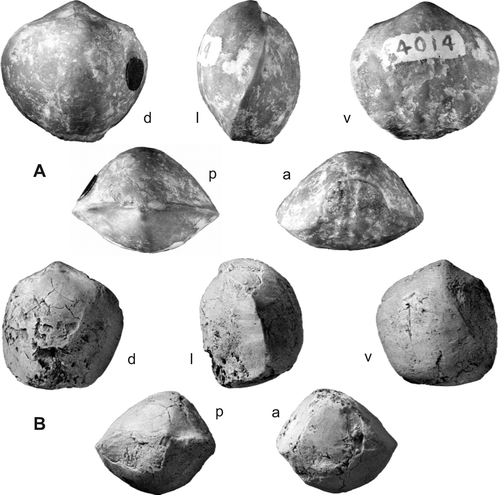
Type specimens
Holotype AMF51717, Limestone Creek east of Bowning (referred to on p. 270 as Silverdale), figured Mitchell & Dun, Citation1920, pl. XVI, . Paratypes (all from Limestone Creek): AMF9730, 9887, 129716, 129717 (Shearsby collection); F29171, figured Mitchell & Dun pl. XVI, ; AMF29172, figured Mitchell & Dun, pl. XV, ; AMF29173, figured Mitchell & Dun, pl. XVI, ; AMF29174, figured Mitchell & Dun, pl. XVI, ; AMF51716, figured Mitchell & Dun, pl. XVI, ; AMF129729, 129730, 129735, 129736, 51718 (Mitchell collection). The originals of Mitchell & Dun pl. XV, , 15 have not been recognised. According to Mitchell & Dun (p. 270), their material came from Mitchell's Lower Trilobite Bed — i.e. the lower Black Bog Shale up to and including the Yarwood Siltstone Member.
Other material
Mitchell coll.: AMF28062, 129718 (Hattons Corner), 28570, 28616, 28722, 129719 – 129725 (Bowning); Laseron coll.: AMF129731 – 129734 (Hattons Corner; the horizon for these specimens is uncertain). Cliftonwood Limestone: GOU48 — CPC39028. Lower Black Bog Shale: KF — ANU9717, 46468 – 46469; GOU4 — CPC39016 – 39017 plus one other. Yarwood Siltstone: KC21 — ANU9719, 9721, 9722; KC48 — ANU9720, 46466; KE (=GOU46) — 28 specimens including ANU46467, CPC39020 – 39027. Rainbow Hill Member: GOU10 — 30 specimens including CPC39018 – 39019.
Distribution
Cliftonwood Limestone (rare), Black Bog Shale and Rainbow Hill Member (basal Rosebank Shale), Yass Syncline.
Age
Homerian or earliest Gorstian to late Ludfordian.
Etymology
Named in honour of John Mitchell, for his extensive contribution to palaeontological studies of the Yass sequence during his time as school teacher at Bowning.
Diagnosis
Medium-sized Spirigerina, dorsibiconvex, transversely oval shell with prominent ventral beak, apsacline area, anteriorly prominent more or less subrectangular dorsal fold; mostly 21 – 26 strong, rounded, anteriorly expanding, variably sized ribs on ventral valve, of which 5 – 7 are in sulcus; ventral mid-rib pair initially raised to form posterior keel, anteriorly more subdued and positioned on flanks of sulcus; fine median rib inserted in sulcus at about a third valve length; dorsal fold replaces initial shallow sulcus, strongly raised marginally in adult shells.
Description
Shell of medium size (largest observed — Ls 13.5 mm, Ws 18.2 mm); for most adult shells Ls 10 – 12 mm, Ws 11 – 14 mm, Ts 4 – 8 mm. Juvenile shells () lenticular, dorsal valve a little more convex than ventral; with growth, dorsal valve becomes more convex (greatest curvature in anterior half), this accentuated by increasingly prominent fold; adult Ts/Ls 0.5 – 0.6, Ts/Ws more variable, mostly 0.35 – 0.5. Juvenile shells subcircular, adult shells transversely oval in outline (Ls/Ws mostly 0.8 – 0.95), commonly anteromedially indented (depending on longitudinal profile of dorsal fold), with greatest width at 0.5 – 0.7Ls (). Ventral beak prominent, fairly sharp; area weakly to moderately apsacline; delthyrium large, with large circular foramen at apex, and triangular deltidial plates that remain disjunct. Posterior shell margins concave but not indented, cardinal margin gently curved, fairly wide (CM/Ws usually 0.6 – 0.7), cardinal extremities rounded. Dorsal beak low, rounded.
Ventral valve () with gently convex to gently concave flanks, low posterior keel formed by raised mid-rib pair giving way with growth to increasingly prominent sulcus with subrectangular to somewhat rounded transverse profile. Margins of sulcus initially defined by diverging mid-rib pair, which split about 2 – 3 mm from beak, diverging to allow insertion of an always relatively fine mid-rib. Inner branches of initial rib pair lie on increasingly steep flanks of sulcus and consequently become more subdued, while outer branches remain prominent and define sulcus anteriorly; branches split again towards margin. Dorsal valve with weak posterior sulcus, with strong mid-rib inserted at 2 – 3 mm from beak, which expands with growth, dividing before mid-length to form strong pair on axis of increasingly prominent fold whose other ribs arise mostly by insertion. Ribs strong, rounded, expanding distally, increasing in number by both splitting and intercalation, of variable size marginally, moderately to strongly curved posterolaterally on flanks (). At commissure, usually 21 – 26, rarely up to 30 ribs on ventral valve, with 5 or 7 in sulcus. Growth lines mostly fine and subdued, but there may be sporadic more prominent ones.
Ventral interior () with small triangular teeth supported by short, thin, divergent dental plates; dental cavities slit-like. Thin pedicle callist at valve apex. Ventral muscle field not visible. Sockets small, widely divergent, bounded by valve margins and narrow inner socket ridges ending in small upright crural bases. Short narrow myophragm at valve apex. Crura and spiralia not seen.
Comparison
Spirigerina mitchelli is externally similar to several Silurian and Early Devonian species close to the type species, especially in size, shape, and ribbing. It differs from S. marginalis (Wenlock, Gotland) in its fewer and coarser ribs of less uniform size that expand distally more strongly, and by a fold that is usually subrectangular in section; internally, the hinge structures are more delicate. The slightly younger S. lockwenia Copper, Citation2004 (late Wenlock, Britain) is larger, with a more marked ventral posterior keel and a more pronounced ventral tongue; the paired ribs bordering the sulcus and forming the fold are much more prominent, the fold is flanked by distinct furrows, and marginal growth lamellae are commonly developed in adult shells. Internally, it differs from S. mitchelli in its strong teeth, thicker pedicle callist, and bulbous inner socket ridges.
Spirigerina mitchelli differs from the late? Llandovery S. sinensis (Wang, Citation1962) (see Rong & Yang Citation1981, pl. XVII, – 38, 40; Wang et al. Citation1987, pl. III, figs 25 – 28, 36 – 37) in being less transverse, with a subrectangular fold, coarser ribs, which are more strongly curved laterally and not medially subdued, disjunct deltidial plates, smaller teeth and slit-like dental cavities. The Wenlock? S. groenlandica Poulsen, Citation1943 has fewer ribs, an anteriorly less prominent fold of rounded section, which does not enclose a prolonged ventral tongue, and a smaller, more upright ventral beak. Spirigerina mitchelli differs from S. sigismunda Havlíček in Havlíček & Štorch, Citation1990 (late Ludlow, Prague Basin) in its subrectangular tongue, more robust and strongly curved lateral ribs, greater adult thickness, and apsacline ventral area.
Savage (Citation1970, p. 659) placed Plectatrypa australis Philip, Citation1962 (Lochkovian, Victoria) in synonymy with S. supramarginalis Khalfin, Citation1948 (Lochkovian, Altai Mts; see also discussion by Farrell Citation1992). As described by Gratsianova (Citation1967), the latter differs from S. mitchelli in its less prominent and blunter ventral beak, and its straight posterolateral margins; it also lacks the fine ventral midrib. Following comments by Perry (Citation1984), this Lochkovian species can also be distinguished by the subdued ribs in the tongue.
Suborder LISSATRYPIDINA Copper, 1996
Superfamily LISSATRYPOIDEA Twenhofel, 1914
Family LISSATRYPIDAE Twenhofel, 1914
Atrypoidea Mitchell & Dun, Citation1920
Type species
Meristina (?) australis Dun, Citation1904; Ludlow, New South Wales.
Subgenus Atrypoidea Mitchell & Dun, Citation1920
Remarks
The type species was fully redescribed, including internal structures (based on serial sections of topotypic specimens) by Copper (Citation1977). He also redescribed the type species of Atrypella Kozłowski, Citation1929 (Atrypa prunum Dalman, 1828), showed that there were no significant differences between the two genera, and placed Atrypella in synonymy with Atrypoidea. Copper (Citation2004, p. 119) further revised Atrypoidea prunum on the basis of many specimens from Gotland, and listed the numerous species assigned to the genus. In view of the variability shown by the better-known species of this genus (see e.g. Jones Citation1974, Citation1979, Citation1981; Jones & Rong Citation1982; Copper Citation2004), specific discrimination is not simple, and the validity of some of these species should probably be questioned.
Atrypoidea (Atrypoidea) australis (Dun, Citation1904) ( – )
Fig. 17. Atrypoidea (Atrypoidea) australis (Dun, Citation1904). A – G show development and variability during growth. A, AMF129757. B, AMF129771. C, AMF129758. D, AMF129770. E, AMF29183, figured by Mitchell & Dun (Citation1920, pl. XIV, – ). F AMF29184, figured by Mitchell & Dun (Citation1920, pl. XIV, – ). G, AMF29186, figured by Mitchell & Dun (Citation1920, pl. XIV, ). H, paralectotype AMF46736 (dorsal valve and ventral umbo heavily eroded), figured by Dun (Citation1904, ). I, CPC24009, figured by Strusz (Citation1984, ). J, CPC39038. K, L, ANU9736, latex replicas of ventral exterior and interior. M, ANU15626, latex replica of dorsal interior. N, ANU15609, latex replica of dorsal interior. O, P, ANU9735, latex replica of ventral interior in dorsal and anterodorsal views, showing strongly developed vascular imprints. A-E, H Molong, Molong Limestone; G, Hattons Corner, Silverdale Fm?; I, J, loc. GOU49, Yass Fm.; K – N, loc. KC21, Yarwood Siltstone Member; O, P, loc. KC51, upper Black Bog Shale. Letters d , l , v , p , a — dorsal, lateral, ventral, posterior, and anterior views. A – H, J – L, O – P ×1.5; I ×6; M, N ×4.
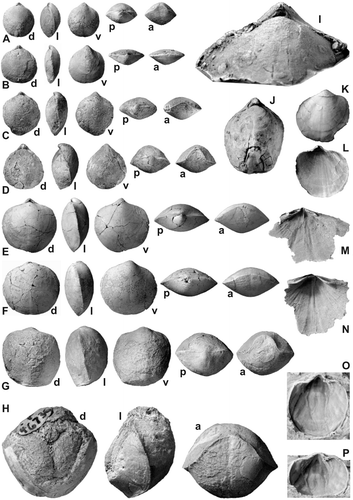
Fig. 18. Atrypoidea (Atrypoidea) australis (Dun, Citation1904). A, AMF29200, figured by Mitchell & Dun (Citation1920, pl. XIV, fig. 27 as A. angusta). B, AMF29188, figured by Mitchell & Dun (1929, pl. XIV, as A. australis). C, AMF17432, labelled A. australis. D, AMF14215, labelled A. australis. A – C, Hattons Corner, Silverdale Fm?; D, Glenbower, Glenbower Fm. Letters d , l , v , p , a — dorsal, lateral, ventral, posterior, and anterior views. All ×1.5.
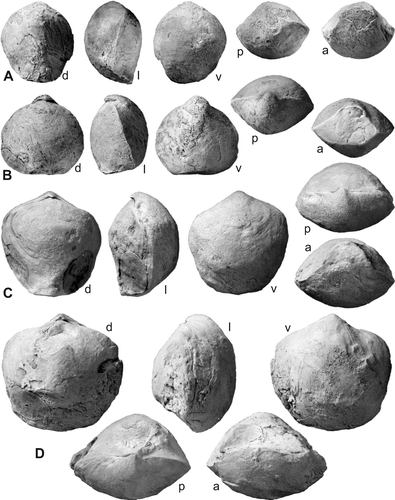
Fig. 19. Atrypoidea (Atrypoidea) australis (Dun, Citation1904). A, AMF29185, figured Mitchell & Dun Citation1920, pl. XIV, fig. 29 as A. angusta. B, AMF29196, figured by Mitchell & Dun (Citation1920, pl. XIV, figs 25 – 26 as A. angusta). C, AMF29195, figured by Mitchell & Dun (Citation1920, pl. XIV, fig. 24 as A. angusta). D, AMF29193, figured by Mitchell & Dun (Citation1920, pl. XIV, , as A. australis and as A. angusta). E, AMF29192, figured by Mitchell & Dun (Citation1920, pl. XIV, – as A. australis). All Molong Limestone. Letters d , l , v , a — dorsal, lateral, ventral, and anterior views. All ×1.5.
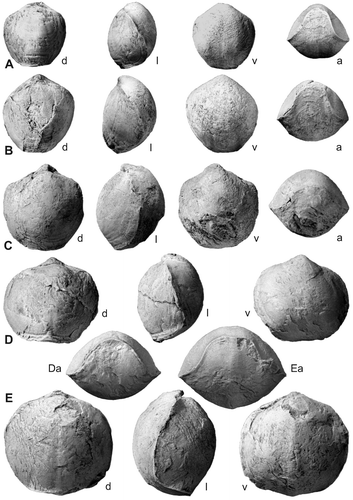
Fig. 20. Atrypoidea (Atrypoidea) australis (Dun, Citation1904). Plots of Ls, and the ratios Ls/Ws, CM/Ws against Ws. Dots indicate specimens from the Molong Limestone, crosses those from the late Wenlock of the Canberra-Yass region, x for specimens from the Ludlow of Yass. an — specimens previously identified ad A. angusta (an* — lectotype); au* — lectotype, A. australis.
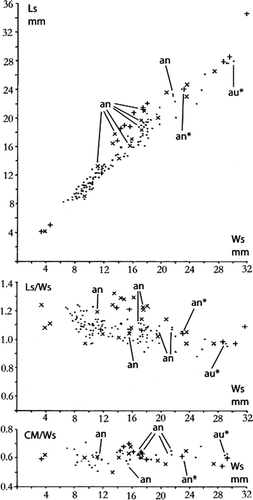
Fig. 21. Atrypoidea (Atrypoidea) australis (Dun, Citation1904). Plots against Ls of the ratios Ts/Ls, L(Wmax)/Ls, and ADAC/Ls. Symbols as in .
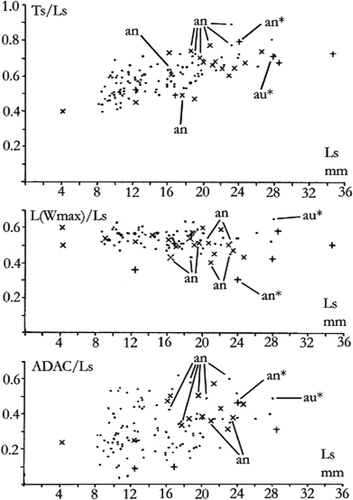
1904 Meristina (?) australis Dun, p. 318 – 319, LXI, 3a – e.
1920 Atrypoidea australis; Mitchell & Dun, p. 272, XIV, 1 – 18, XV, 8 – 9, XVI, 7, 13.
1920 Atrypoidea angusta Mitchell & Dun, p. 273, XIV, 20 – 29.
1977 Atrypoidea australis (Dun, Citation1904); Copper, p. 18 – 21, 2, 3(1 – 4), 4.
?1982 Atrypoidea sp. indet. Strusz, p. 127, . 1982a
Fig. 22. Meifodia? sp. cf. M. lenticulata (Philip, 1960). A, MMF27958J, latex replica of ventral exterior. B, C, MMF27995, ventral internal mould and latex replica. D, MMF27994B, latex replica of ventral interior. E, F, MMF27993, dorsal internal mould and latex replica. G, MMF27957I, ventral internal mould. H, MMF27958, latex replicas of adjacent ventral exteriors. I, ANU46479, latex replica of ventral interior. J, MMF27981, latex replica of dorsal interior. K, L, ANU46480, latex replica of ventral interior. M, MMF27973B, latex replica of dorsal interior. A – G, I – K, M ×4; H, L ×2.

1984 Atrypoidea australis (Dun, Citation1904); Strusz, p. 136 – 139, 12 – 14.
1984 Atrypoidea sp. Strusz, p. 138, .
?1985 Atrypoidea sp. indet. Strusz, p. 113 – 115, .
Material
Lectotype MMF4014 (Dun, pl. LXI, ; Copper, (1 – 5)). Paralectotypes AMF46736 (Dun, ; formerly MMF4013), F46737 (Dun, ; formerly MMF4010). Molong Limestone, Late Silurian, NSW, collected C. Cullen 1902.
Dun (Citation1904) did not specify the exact source of the type material, nor did Mitchell & Dun (Citation1920). From information provided by the NSW Geological Survey, Copper (Citation1977) reported it as being about 3 km northwest of Molong, and that the bulk of the Molong material used by Mitchell & Dun (Citation1920) came from the Nandillyan Limestone further northeast, in the Parish of Boomey. More precisely, the type locality (not listed in 1920) was in the eastern part of Permanent Common W.76.1834, Parish of Bell, some 3 km west-northwest of Molong railway station (approximate grid reference 720.375 on the Molong 1:100 000 geological map), and has since been removed by quarrying. From an examination of the material and of documentation held by the NSW Geological Survey, J. Pickett, I. Percival, and I have concluded that most of the Molong material in fact came from localities in the Molong Limestone (not necessarily just the type locality), especially in the general vicinity of the Foys Creek section reported by Pickett (Citation2003). These specimens are pale to medium grey and are crack-out specimens from clean limestone, some showing partial loss of the outer shell layer. A few much darker specimens, in some cases with a little terrigenous sediment adhering, could be from the less pure Nandillyan Limestone in the Parish of Boomey (although Pickett reports that he has never seen the species there). The scant locality details with the Mitchell collection in the Australian Museum, and provided by Mitchell & Dun (Citation1920), are not very informative.
The lectotype of Atrypoidea angusta, selected by Copper (Citation1977) is AMF29197, ostensibly from ‘Gurnett's farm, 3 miles west of Bowning’ near Yass. The locality was discussed by Strusz (Citation1984, p. 138); it is likely that Mitchell's specimen was collected by Gurnett, and that Mitchell misunderstood him when discussing where the specimen came from. The locality remains unknown.
Other material
Topotypes MMF 4011a – c, 4073a – b, 5311 and 19639 (collected by Cullen 1902). From nearby localities (also collected by Cullen): MMF5308 (Por. 146, Ph Bell), 5309 (Por. 147, Ph. Bell). Australian Museum specimens from the Molong district (ex Mitchell Colln but precise locality not specified): AMF28594, 28686, 28687, 28966, 29165, 29170, 29180, 29183 (Boomey? — Mitchell & Dun, Citation1920, pl. XIV, – ), 29184 (Boomey? — Mitchell & Dun Citation1920, pl. XIV, – ), 29185 (Mitchell & Dun Citation1920, pl. XIV, fig. 29 — A. angusta), 29190, 29192 (Boomey? — Mitchell & Dun, Citation1920, pl. XIV, – ), 29193 (Boomey? — Mitchell & Dun, pl. XIV, , 12 — as A. australis, and 23 — as A. angusta), 29194, 29195 (Mitchell & Dun Citation1920, pl. XIV, fig. 24 — A. angusta), 29196 (Mitchell & Dun Citation1920, pl. XIV, figs 25 – 26 — A. angusta), 29362, 29363, 29364, 29365, 29386, 29387, 129737 – 129766, 129768 – 129801, 129805 – 129834.
Australian Museum specimens from the Yass district: Boambolo & Glenbower (Glenbower Formation, equivalent to the Yass Formation) — AMF9002 (coll. Shearsby 1903), 9528, 9560 – 9562 (coll. Shearsby 1904), 14215 (coll. Anderson 1908). Bowning (Mitchell Colln) — AMF29067, 29191 (Mitchell & Dun Citation1920, pl. XIV, – ), 129802 – 129804. Hattons Corner, Yass River: coll. Dun 1918 — AMF17429 – 17434; Mitchell Colln — AMF28576 & 129767 (labelled A. angusta), 29186 (Mitchell & Dun Citation1920, pl. XIV, ), 29187 (labelled A. angusta), 29188 (Mitchell & Dun Citation1920, pl. XIV, ), 29200 (Mitchell & Dun Citation1920, pl. XIV, fig. 27 — A. angusta).
Geoscience Australia specimens from the Yass Syncline: Yass Formation: GOU48 — 12 rather poor specimens, including CPC39032 – 39035; GOU49 — 55 specimens including CPC24009, 39036 – 39042. Yass Formation or basal Silverdale Formation: GOU51L + U — 18 specimens including CPC39043. Silverdale Formation: GOU2 — CPC39029. Black Bog Shale: GOU7 — CPC39030; GOU46 — 4 specimens including CPC39031.
ANU specimens from the Yass Syncline (Kemezys Colln): Black Bog Shale: ANU9731 – 9736, 15609, 15626, 46470 – 46471, 46473 – 46475 (all from general locality KC, mostly Yarwood Siltstone Member).
The originals of Mitchell & Dun (Citation1920), pl. XIV, , – , , 28, pl. XVI, , cannot be recognised in the Australian Museum collections.
Distribution
Possibly Canberra Formation and Walker Volcanics, certainly Yarralumla Formation, Canberra; Yass Formation (the only occurrence reported by Shearsby, Citation1912), Silverdale Formation (especially Barrandella Shale Member) and Black Bog Shale (up to but not certainly above the Yarwood Siltstone Member), Yass Syncline; Boambolo and Glenbower Formations, Boambolo area SW of Yass; upper Molong and probably Nandillyan limestones, Molong district.
Age
Homerian? to early? Ludfordian; the upper Molong Limestone is no older than early Ludfordian (Polygnathus siluricus Zone; Pickett Citation2003), whereas the Nandillyan Limestone is of Wenlock age (Percival Citation1998).
Diagnosis
Large, biconvex, generally rotund Atrypoidea, mostly somewhat longer than wide, with weak fold and sulcus but usually large rounded dorsal deflection of anterior commissure, moderately curved lateral commissure; large delthyrium with narrow deltidial plates in smaller shells, obscured in larger shells with low, incurved ventral beak adpressed to dorsal umbo; cardinal extremities rounded; teeth and conical sockets widely divergent.
Description
Shell smooth, large (width to 32 mm, length to 35 mm, thickness to 25 mm; – ). Outline subcircular to somewhat elongate oval, in some cases shield-shaped or subpentagonal, Ls/Ws highly variable (0.74 – 1.32) but mostly between 0.95 and 1.25 and decreasing with increasing size so that very large shells tend to be equant (see , plot of Ls/Ws against Ws). Greatest width is generally at or slightly in front of mid-length, with no recognisable change during growth (mean L(Wmax)/Ls 0.53, mode 0.5 – 0.6; see ). Lateral profile biconvex to dorsibiconvex (especially large, thick shells with strong anterior deflection); Ts/Ls less variable than Ts/Ws, increasing from 0.4 – 0.7 in juveniles to 0.65 – 0.89 in shells >20 mm long; small shells are mostly lenticular. Dorsal valve generally most convex longitudinally in posterior half, and transversely near centre of shell (in some cases forming weakly defined anterior fold). Ventral valve generally more even, becoming medially flattened anteriorly to form poorly defined and very shallow sulcus. Some large shells have faint median dorsal furrow, ventral ridge. Cardinal margin gently concave, CM/Ws 0.5 – 0.7. Ventral beak sharp and sub-erect in juveniles, broader and erect to incurved in adults, adpressed to dorsal umbo in large, thick shells. Apical angle 95 – 145°, increasing with absolute length (Ls) and elongation (Ls/Ws), but not correlated with relative width of cardinal margin. Lateral commissure straight in neanic shells, moderately (in a few cases strongly) curved in adults. Anterior commissure variably deflected dorsally, the deflection nearly always rounded, parabolic. Variation is considerable — in juveniles, deflection varies from none to about half shell thickness, at lengths over 20 mm it is generally about 1/3Ts, but can approach 2/3Ts. Delthyrium large, triangular, with narrow deltidial plates separated by large pedicle opening, which commonly truncates beak (usually obscure in large shells).
Delthyrial cavity somewhat thickened, longitudinally striated; muscle field impressed, suboval to subtriangular, flanked by divergent furrows, usually straight, continuous with vascula myaria. Rarely, vascular media also preserved. Ovarian impressions weak to strong. Teeth narrow, triangular, divergent, separated from cardinal margin by narrow grooves. Dental sockets conical, widely divergent, overhung by cardinal margin and inner socket ridges; crural bases narrow, attached to inner faces of socket ridges. Muscle field large, weakly impressed, cordate, radially weakly striate, with short, low median ridge posteriorly in some. For details of spiralia and other features, see Copper (Citation1977).
Discussion
As noted by Strusz (Citation1984), the relationship between the species Atrypoidea australis and A. angusta could only be based on a full redescription of all available Molong and especially Yass material. This has now been done, but it must be borne in mind that by 1920 the collections from the various cited localities might not have retained their integrity. This confusion is clear even in the illustrations by Mitchell & Dun (Citation1920), where the same specimen from Molong, AMF29193, is figured in different aspects as both species. The problems with the Molong material have already been alluded to above. Moreover, the type specimen of A. angusta ostensibly came from a locality that can not now be found [there are few outcrops on Gurnett's farm, none fossiliferous, and from Link's map (in Link & Druce Citation1972) the farm is on the Willow Bridge Tuff]. Finally, the number of specimens from Mitchell's collection identified as A. angusta is significantly smaller than those placed in A. australis.
Mitchell & Dun (Citation1920) cited several characters distinguishing their species, which are addressed below. It should also be noted that they could not distinguish between the species among ‘very immature shells’.
‘[A. angusta] differs in being much more biconvex … greater relative thickness ….’ Certainly the type specimen is large and rotund, but only it and one other specimen (from Molong) lie outside the envelope of variability for A. australis on a plot of Ts/Ls against Ls (), and that variability is considerable. This is not a convincing character distinction.
‘[A. angusta] differs in … having a less conspicuous umbo, more strongly incurved and depressed beak’. When size is taken into account, this is not borne out. Juveniles have relatively sharp, suberect to erect beaks; as size and rotundity increase, the beak broadens and incurvature increases until the ventral beak is adpressed on the dorsal umbo.
‘[A. angusta] differs in … narrower hinge line’. A plot of CM/Ws against Ws () shows no distinction, and, incidentally, no change with increasing size.
‘[A. angusta] differs in … greater length than width’. A plot of Ls against Ws () shows considerable overlap between specimens assigned (according to museum labels) to A. australis and A. angusta, with the majority of specimens having Ls > Ws; variability is surprisingly low. A plot of Ls/Ws against Ws () shows greater variability, with the type of A. angusta lying within the envelope for Molong specimens labelled A. australis, and well within that for the more variable Yass specimens. What the latter plot clearly shows is that there is a gradual shift in Ls/Ws with growth, from about 1 – 1.2 in juveniles to about 0.9 – 1.1 in larger shells. The type specimen of A. australis is larger than the type of A. angusta (see ).
‘[A. angusta] differs in … much stronger sinuosity of the lateral and front margins’. Inspection shows significant variability but no consistent pattern, other than a tendency for rotund shells with a large dorsal deflection of the anterior margin to have more strongly curved lateral margins. The only measurable feature is the degree of deflection (A.D.A.C. and R.D.A.C. of Jones Citation1974). A plot of ADAC/Ls against Ls () shows considerable variation, especially among juvenile shells, the ratio varying from 0 to 0.6. Specimens assigned to A. angusta do cluster towards the high end, but only one lies outside the envelope for A. australis, and the ratio is less in the type of A. angusta than in that of A. australis.
On all counts, therefore, the two species cannot be reliably distinguished. Given also that Mitchell & Dun (Citation1920, p. 273) stated that their localities and horizons were the same, it is reasonable to consider them conspecific.
All the specimens reported from the Yarralumla Formation (an equivalent of the Yass Formation) by Strusz (Citation1984) are similar to those from Yass and Molong. The only distinction I can make is in the position of maximum width, which tends to be posterior (L(Wmax)/Ls about 0.35 – 0.40); in this they are closer to the small number of specimens originally assigned to A. angusta (0.40 – 0.53) than to the generality of A. australis (0.40 – 0.68) — see .
Strusz (Citation1982a) described a small number of specimens from the slightly older Walker Volcanics near Canberra, noting that they differed from most species in their low convexity and very shallow anterior sulcus. Ls/Ws plotted against Ws shows considerable variability, with about half the specimens significantly wider (range 0.74 – 1.16) than is usual for A. australis. All the specimens are detached valves preserved as moulds, so that estimated convexity might be too low. In all other respects they appear to be very similar to A. australis, so they are tentatively included in the species. The material described by Strusz (Citation1985) from the probably even older Canberra Formation comprises a few small or incomplete specimens at that time considered inadequate for specific identification. They are very similar to juvenile A. australis from Molong, and so are here tentatively assigned to that species.
Atrypoidea is a relatively featureless and highly variable atrypoid brachiopod, and many species have been poorly described and illustrated, making comparison difficult and all too often pointless. The Gotland species have recently been revised by Copper (Citation2004); all come from various levels in the Gorstian Hemse Beds. The oldest is A. sulcata (Lindström, Citation1861) from the basal Hemse Beds; it is smaller and less rotund, and has distinctive median furrows on both valves. Atrypoidea prunum is from the middle of the Hemse Beds; it is noticeably more elongate than A. australis, reaches a larger size (up to 45 mm long, 34 mm wide, 32 mm thick), and generally has a well-developed fold and sulcus anteriorly. Atrypoidea hemsea Copper, Citation2004 (upper Hemse Beds), is comparable in size, but is less rotund, and has a subtriangular outline with a wide, strongly curved cardinal margin. Jones & Rong (Citation1982) examined the faunas from Arctic Canada and southern China, from which a total of 10 or 11 species have been described. Atrypoidea foxi (Jones, Citation1974), conveniently re-illustrated by Jones & Rong (Citation1982), from the Ludlovian Douro Formation of Arctic Canada and Kuanti Formation of southern China, is generally more elongate than A. australis, but is otherwise quite similar externally.
Meifodia Williams Citation1951[=? TyrothyrisÖpik Citation1953]
Type species
Hemithyris subundata McCoy, 1851; Llandovery, Wales.
Discussion
Williams (Citation1951) based his description on moulds from the Rhuddanian (Early Llandovery) of Wales, and assigned this genus to the Meristellidae (but discussed the possibility that it was a smooth atrypid). Boucot et al. (Citation1964, p. 812) reported the presence of atrypacean spiralia in specimens of Llandovery age from near Oslo, without further detail. Copper (Citation1995) fully revised the internal structure on the basis of serially sectioned specimens from the Rhuddanian middle Solvik Formation, which he identified as Meifodia cf. subundata. The sections were refigured by Copper (figs 993.1e-g in Kaesler Citation2002), and again by Copper (Citation2004, fig. 74), in the last instance reidentified as Meifodia cf. prima Williams, Citation1951, which was originally described as a subspecies of M. subundata.
Öpik (Citation1953) similarly erected Tyrothyris (type species T. tyro) on the basis of moulds from the ‘Illaenus Band’ in the Wapentake Formation of the Heathcote region, Victoria. He regarded the horizon as being of Llandovery age, but it has since been re-assessed as Wenlock (Sandford & Holloway Citation1998, p. 915; Rickards & Sandford Citation1998, p. 751). Öpik thought his genus was punctate, and represented a group of uncertain affinity homeomorphic with meristellids. Boucot et al. (Citation1964, p. 812) considered the punctae to be probably of secondary origin, and regarded Tyrothyris as a junior synonym of Meifodia. Talent (Citation1965, pp. 36 – 37) reported that subsequently collected specimens of Tyrothyris lacked any sign of ‘punctae’, and that a sectioned steinkern showed typical atrypoid spiralia. He, too, considered Tyrothyris a synonym of Meifodia.
All of the above authors have referred to the difficulty of identifying smooth atrypoids in the absence of details of spiralia and jugal structures. In the Australian context, this inevitably leads to a discussion of the species that have been assigned to the two rather widely distributed Silurian genera Meifodia and Lissatrypa, and leaves the position of Tyrothyris still questionable. Philip (Citation1962) described L. lenticulata from the Lochkovian Boola Formation of Victoria using only moulds, relying on comparison with specimens assigned to the type species by Kirk & Amsden (Citation1952), and made mention of neither Tyrothyris nor Meifodia. Savage (Citation1974, p. 39) noted the revised position of Tyrothyris tyro, and thought it ‘must be considered very close to Lissatrypa lenticulata’, and that ‘If Lissatrypa lenticulata is a true Lissatrypa it seems probable that Tyrothyris is the junior synonym of Lissatrypa rather than of Meifodia’. He was again using only moulds, and did not explain why he thought the change should be made. Lenz & Johnson (Citation1985) had only poorly preserved silicified specimens of Pragian age, and could make no contribution to the problem.
When confronted with moulds, in which the details of the spiralia and jugal structures are unavailable, generic distinction can only be made on external characters (shape, sulcation, beak attitude, etc), ventral and dorsal musculature, and details of the cardinalia. All are variable, and many are common to most genera within the Lissatrypidae. For the Australian Wenlock to Pragian lissatrypid species, one can rule out Australina not only on palaeogeographic grounds, but also because all are biconvex, not concavo-convex or plano-convex. The choice really lies between Meifodia (tentatively including Tyrothyris) and Lissatrypa, the latter long considered to be derived from the former during the Wenlock, and any generic assignment must remain uncertain.
From the definitions of Copper (in Kaesler Citation2002) and the extended discussion in Copper (Citation2004), conflicting conclusions can be drawn. Lissatrypa is lenticular and lacks a distinct fold on the dorsal valve, whereas Meifodia is more inflated, the fold at least anteriorly strong (in that respect very like Septatrypa). The Australian shells are lenticular but relatively thick, and lack distinct folds. Adult Lissatrypa generally have inflated hinge plates and ‘virtually no cardinal pit’ (Copper Citation2004, p. 110, who considered the resulting bulbous cardinal-process-like structure to be unique among atrypids), but in juveniles the plates are disjunct (Copper, pers. comm. 2006); the hinge plates in adult Meifodia are separated by a usually deep slot (cardinal pit), and are strong but not swollen. Lissatrypa lenticulata and T. tyro have separate hinge plates that are moderately to fairly strongly swollen, L. ventrosulcata Brock, Citation2003, has thick conjunct hinge plates. For want of information to the contrary, I here provisionally refer the specimens with disjunct hinge plates to Meifodia, those with conjunct hinge plates to Lissatrypa. Therefore, L. lenticulata is transferred to Meifodia, even though this does significantly extend the known stratigraphic range of the latter from Llandovery (or Wenlock if Tyrothyris is indeed a synonym) to Lochkovian. To finally resolve the matter will require specimens of each of the species with the spiralia and jugal structures intact.
Meifodia? sp. cf. M. lenticulata (Philip, Citation1962) ( – )
Fig. 23. Meifodia? sp. cf. M. lenticulata (Philip, 1960). Plot of Ls against Ws for Devonian M. lenticulata from Victoria (crosses), Manildra NSW (x) and Wellington NSW (o), and Silurian M. sp. cf. M. lenticulata from Yass (dots).
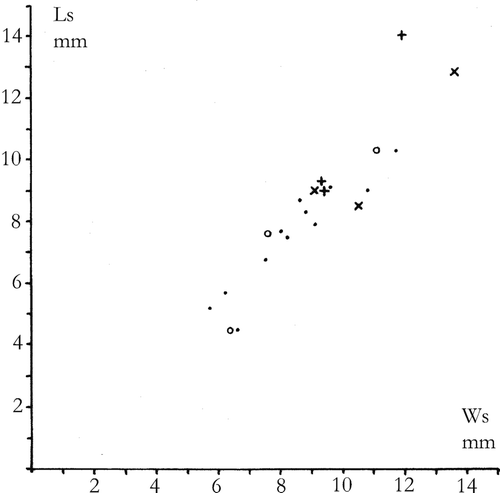
cf. 1962 Lissatrypa lenticulata Philip, p. 220 – 221, pl. XXXIV, , – .
cf. 1965 Lissatrypa cf. lenticulata; Talent, p. 35, pl. 8, – , – , – .
cf. 1974 Lissatrypa lenticulata; Savage, p. 38 – 39, pl. 10, figs 16 – 30.
cf. 1985 Australina? lenticulata; Lenz & Johnson, p. 82, pl. 8, – .
Material
Portion 34, Parish of Derrengullen — MMF27957I, 27958B, D, J-N, 27973B, 27974B, 27975, 27979 – 80, 27981, 27982D-E, 27983 – 86, 27987A-B, 27988, 27995. Portion 36, Parish of Derrengullen — MMF27993 – 94. All collected by K. Sherrard c. 1935. KM — ANU46536, 46476 – 46480.
Distribution
Cowridge Siltstone.
Age
Přídolí, Monograptus parultimus Zone.
Description
The material consists of external and internal moulds in a fine-grained sandstone, the valves are mostly dissociated, and preservation is generally mediocre ().
Shell biconvex, moderately thick, outline slightly transverse-oval (Ls/Ws 0.60 – 1.01, mode ca 0.9); longitudinal profiles of both valves evenly convex; greatest Ws 11.7 mm. Ventral beak small, low, with open delthyrium and small apical foramen, dorsal beak obscure (Ld/Ls ca 0.95). Narrow, shallow to faint median sulci on neither, one, or both valves; anterior commissure rectimarginate to weakly sulcate, in some cases slightly ligate. Surface smooth except for short, fairly evenly spaced growth lamellae, most prominent towards valve margins. Shell fairly thick, especially posteriorly, but some growth lamellae expressed internally.
Teeth strong, triangular, widely divergent, cyrtomatodont, supported on thickened posterolateral valve walls; no dental cavities. Delthyrial cavity with well-developed pedicle callist. Ventral muscle field subtriangular, extending forward to about Lv/3. Diductor scars strongly impressed, divergent, longitudinally furrowed, separated by prominent but somewhat shorter ridge rising anteriorly above valve floor and bearing subparallel elongate adductor scars. Anterior face of ridge generally steep, flat to concave; anterior margin of muscle field thus arcuate to chevron-shaped. Weak vascula media can be seen extending forward from the diductor scars in a few specimens.
Sockets narrow, deep, strongly divergent, overhung by narrow outer socket ridges; inner hinge plates wide, somewhat swollen, separated by deep, generally slot-like cardinal pit on short notothyrial platform. What could be a tiny cardinal process visible at apex of slot in a few specimens. Broad and variably raised myophragm in front of platform narrows forward, may reach as far forward as Ld/3. Adductor scars small, weakly to moderately impressed on either side of myophragm, in some clearly divided into subquadrate posterior and anterior scars. Crura and spiralia unknown.
Discussion
Talent (Citation1965) commented on the considerable variability shown by both Meifodia tyro (leading him to place Tyrothyris melicertaÖpik, Citation1953, in synonymy with it) and M. lenticulata. In fact, they appear to me difficult to separate. A plot of length against width (from illustrated specimens) suggests that M. tyro is circular, M. lenticulata slightly transverse, but the distinction is very weak. I separate the two on the basis of the relative length of the ventral muscle field (approaching mid-length in M. tyro, shorter in M. lenticulata) and less confidently on the generally less robust appearance of the cardinalia in M. lenticulata — a highly variable feature, however. On those factors, and the length – width plot, I consider the Yass specimens intermediate between the two, but closer to M. lenticulata. This is in accord with the relative ages of the Victorian and New South Wales occurrences.
Acknowledgements
My thanks go to Michael Doyle (formerly of Geoscience Australia), Richard Barwick (ANU) and David Barnes (NSW Dept of Primary Industries) for assistance with photography. Discussion of the Molong localities owes much to the work of Ian Percival and John Pickett (NSW Geological Survey), and the first draft of this paper benefited from careful examination by Ian Percival. I have also received helpful comments and information from Paul Copper (Laurentian University). My thanks also go to Prof. Richard Arculus for provision of continuing support in the Dept of Earth and Marine Sciences, ANU.
References
- Alekseyeva , R. E. 1960 . O novom podrode Atrypa (Desquamatia) subgen. n. semeystva Atrypidae Gill (brakhiopody) . Doklady Akademiya Nauk SSSR , 131 : 421 – 424 . (Russian)
- Alekseyeva , R. E. 1962 . Devonskiye atripidy Kuznetskogo i Minusinskogo basseynov i vostochnogo sklona severnogo Urala , 196 Moskva : Akademiya Nauk SSSR . (Russian)
- Alexander , F. E.S. 1949 . A revision of the brachiopod species Anomia reticularis Linnaeus, genolectotype of Atrypa Dalman . Quarterly Journal of the Geological Society, London , 104 : 207 – 220 .
- Amsden , T. W. 1949 . Stratigraphy and Paleontology of the Brownsport Formation (Silurian) of Western Tennessee . Peabody Museum of Natural History Bulletin , 5 : 1 – 138 .
- Amsden , T. W. 1958 . Stratigraphy and paleontology of the Hunton Group in the Arbuckle Mountain region. Part II. Haragan Articulate Brachiopods . Oklahoma Geological Survey Bulletin , 78 : 1 – 144 .
- Boucot , A. J. , Johnson , J. G. and Staton , R. D. 1964 . On some atrypoid, retzioid, and athyridoid Brachiopoda . Journal of Paleontology , 38 : 805 – 822 .
- Boucot , A. J. , Johnson , J. G. and Zhang , N. 1988 . Silurian (Wenlockian) brachiopods from southeastern California . Palaeontographica , 201A : 103 – 127 .
- Brock , G. A. 2003 . Lochkovian (Early Devonian) brachiopods from the Garra Limestone at Eurimbla, New South Wales, Australia. Part 2: Rhynchonellida, Atrypida, Athyridida, Spiriferida . Palaeontographica A , 270 : 49 – 94 .
- Copper , P. 1977 . The Late Silurian brachiopod genus Atrypoidea . Geologiska Föreningens i Stockholm Förhandlingar , 99 : 10 – 26 .
- Copper , P. 1986 . Evolution of the earliest smooth spire-bearing atrypoids (Brachiopoda: Lissatrypidae, Ordovician – Silurian) . Palaeontology , 29 : 827 – 866 .
- Copper , P. 1995 . Five new genera of Late Ordovician — Early Silurian brachiopods from Anticosti Island, eastern Canada . Journal of Paleontology , 69 : 846 – 862 .
- Copper , P. 2004 . Silurian (Late Llandovery — Ludlow) atrypoid brachiopods from Gotland, Sweden, and the Welsh Borderlands, Great Britain , Ottawa : National Research Council of Canada . x + 215
- Copper , P. , Hünicken , M. and Benedetto , J. L. 1988 . The Silurian brachiopod Australina from the Malvinokaffric faunal province . Journal of Paleontology , 62 : 531 – 538 .
- Dun , W. S. 1904 . Notes on some new species of Palaeozoic brachiopods from New South Wales . Records of the Geological Survey of New South Wales , 7 : 318 – 325 .
- Farrell , J. R. 1992 . The Garra Formation (Early Devonian: Late Lochkovian) between Cumnock and Larras Lee, New South Wales, Australia: stratigraphic and structural setting, faunas and community sequence . Palaeontographica , 222A : 1 – 41 .
- Gratsianova , R. T. 1967 . Brakhiopody i stratigrafiya nizhnego devona Gornogo Altaya , 177 Moscow : Nauka . (Russian)
- Hall , J. 1852 . Containing descriptions of the organic remains of the lower middle division of the New York System . New York State Geological Survey, Palaeontology of New York , 6 : 353 [fide Sheehan, 1976]
- Havlíček , V. 1987 . New genera of Silurian brachiopods . V stník Úst edního ústavu geologického , 62 : 239 – 244 .
- Havlíček , V. and Štorch , P. 1990 . Silurian brachiopods and benthic communities in the Prague Basin (Czechoslovakia) . Rozpravy Úst edního ústavu geologického , 48 : 275
- Jenkins , C. 1879 . On the geology of Yass Plains . Proceedings of the Linnean Society of New South Wales, ser. 1 , 3 : 21 – 32 .
- Johnson , J. G. and Boucot , A. J. 1967 . Gracianella, a new late Silurian genus of atrypoid brachiopods . Journal of Paleontology , 41 : 868 – 873 .
- Jones , B. 1974 . A biometrical analysis of Atrypella foxi n. sp. from the Canadian Arctic . Journal of Paleontology , 48 : 963 – 977 .
- Jones , B. 1979 . Atrypoidea erebus n. sp. from the Late Silurian of Arctic Canada . Journal of Paleontology , 53 : 187 – 196 .
- Jones , B. 1981 . Atrypoidea species from the Canadian Arctic islands . Canadian Journal of Earth Sciences , 18 : 1539 – 1561 .
- Jones , B. and Rong , J. -Y. 1982 . Comparison of the Upper Silurian Atrypoidea faunas of Arctic Canada and southern China . Journal of Paleontology , 56 : 924 – 937 .
- Kaesler , R. L. , ed. 1997 . Treatise on Invertebrate Paleontology, Part H, Brachiopoda, Revised, Volume 1: Introduction , Lawrence : Geological Society of America, Boulder, and University of Kansas Press . xx + 539
- Kaesler , R. L. , ed. 2002 . Treatise on Invertebrate Paleontology, Part H, Brachiopoda, Revised, Volume 4: Rhynchonelliformea (Part) , Lawrence : Geological Society of America, Boulder, and University of Kansas Press . i – xxxix + 921 – 1688
- Khalfin , L. L. 1948 . Fauna i stratigrafiya devonskikh otlozhenii Gornogo Altaya . Izvestiya Tomskogo Ordena Trudovogo Krasnogo Znameni Politekhnicheskogo Instituta , 65 : 1 – 464 . (Russian)
- Khodalevich , A. N. 1951 . Nizhnedevonskiy i eifel'skiye brakhiopody Sverdlovskoi oblasti . Trudy Sverdlovskiy Gornyi Institut , 18 : 1 – 169 . (Russian)
- Kirk , E. and Amsden , T. W. 1952 . Upper Silurian brachiopods from southeastern Alaska. Descriptions and illustrations of a fauna from the islands of Kosciusko and Heceta . United States Geological Survey Professional Paper , 233-C : 53 – 66 .
- Kozłowski , R. 1929 . Les Brachiopodes gothlandiens de la Podolie polonaise . Palaeontologia Polonica , 1 : 1 – 254 .
- Lenz , A. C. and Johnson , B. D. 1985 . Brachiopods of the Garra Formation (Lower Devonian), Wellington area, New South Wales, Australia: Rhynchonellida, Spiriferida, Terebratulida . Palaeontographica , 188A : 71 – 104 .
- Lindström , G. 1861 . Bidrag till kännedomen om Gotlands Brachiopoder . Oefversigt af Kongliga Vetenskaps-Akademiens Förhandlingar , 17 : 337 – 382 .
- Link , A. G. and Druce , E. C. 1972 . Ludlovian and Gedinnian conodont stratigraphy of the Yass Basin, New South Wales . Bureau of Mineral Resources Australia Bulletin , 134 : 1 – 136 .
- Mitchell , J. 1887 . Notes on the geology of Bowning, N.S.W. . Proceedings of the Linnean Society of New South Wales, ser. 2, 1 (for 1886) , : 1193 – 1204 .
- Mitchell , J. and Dun , W. S. 1920 . The Atrypidae of New South Wales, with references to those recorded from other states of Australia . Proceedings of the Linnean Society of New South Wales , 45 : 266 – 276 .
- Mizens , L. I. and Sapel'nikov , V. P. 1982 . Rebristye siluriiskiye i lokhkovskiye atripidy vostochnogo sklona Urala , 43 Sverdlovsk : Ural'skiy nauchnyy tsentr, Akademiya Nauk SSSR . (Russian)
- Nikiforova , O. I. 1954 . Stratigrafiya i brakhiopody siluriyskikh otlozheniy Podolii , 218 Moskva : Gosgeoltekhizdat . (Russian)
- Nikiforova , O. I. , Modzalevskaya , T. L. and Bassett , M. G. 1985 . Review of the Upper Silurian and Lower Devonian articulate brachiopods of Podolia . Special Papers in Palaeontology , 34 : 1 – 66 .
- Öpik , A. A. 1953 . Lower Silurian fossils from the ‘Illaenus Band’, Heathcote, Victoria . Memoirs of the Geological Survey of Victoria , 19 : 1 – 42 .
- Percival , I. G. 1998 . The age of the Nandillyan and Narragal Limestones, Molong High, Central Western New South Wales . Quarterly Notes of the Geological Survey of New South Wales , 107 : 12 – 19 .
- Perry , D. G. 1984 . Brachiopoda and biostratigraphy of the Silurian – Devonian Delorme Formation in the District of Mackenzie, the Yukon . Royal Ontario Museum, Life Sciences Contributions , 138 : 243
- Philip , G. M. 1962 . The palaeontology and stratigraphy of the Siluro-Devonian sediments of the Tyers Area, Gippsland, Victoria . Proceedings of the Royal Society of Victoria , 75 : 123 – 246 .
- Pickett , J. W. 2003 . Corals and conodonts from the Molong Limestone (Late Silurian), New South Wales, Australia. [Abstract] . Berichte des Institutes für Geologie und Paläontologie der Karl-Franzens-Universität Graz , 7 : 82
- Poulsen , C. 1943 . The Silurian faunas of North Greenland. II. The fauna of the Offley Island Formation. Part II. Brachiopoda . Meddelelser om Grønland , 72 ( 3 ) : 1 – 60 .
- Rickards , R. B. and Sandford , A. C. 1998 . Llandovery-Ludlow graptolites from central Victoria: new correlation perspectives of the major formations . Australian Journal of Earth Sciences , 45 : 743 – 763 .
- Rong , J. -Y. and Yang , X. -C. 1981 . Middle and late Early Silurian brachiopod faunas in Southwest China . Memoirs of the Nanjing Institute of Geology and Palaeontology, Academia Sinica , 13 : 163 – 270 . (in Chinese; English summary, pp. 263 – 270)
- Rong , J -Y. , Xu , H. -K. and Yang , X. -C. 1974 . “ Silurian Brachiopoda ” . In Handbook of Stratigraphy and Palaeontology of Southwest China , Edited by: Nanjing Institute of Geology & Palaeontology, Academia Sinica . 195 – 208 . Nanjing : Science Press . [fide Wang, Y., Boucot, A.J., Rong J.-Y. & Yang, X.-C., 1987 — Community paleoecology as a geologic tool: the Chinese Ashgillian – Eifelian (latest Ordovician through early Middle Devonian) as an example. Geological Society of America Special Paper 211]
- Rubel , M. P. 1970 . Brakhiopody Pentamerida i Spiriferida Silura Estonii , 132 Tallinn : Valgus . (Russian)
- Sandford , A. and Holloway , D. J. 1998 . The effaced styginid trilobite Thomastus from the Silurian of Victoria, Australia . Palaeontology , 41 : 913 – 928 .
- Savage , N. M. 1970 . New atrypid brachiopods from the Lower Devonian of New South Wales . Journal of Paleontology , 44 : 655 – 668 .
- Savage , N. M. 1974 . The brachiopods of the Lower Devonian Maradana Shale, New South Wales . Palaeontographica , 146A : 1 – 51 .
- Shearsby , A. J. The geology of the Yass District . Reports of the 13th Meeting of the Australasian Association for the Advancement of Science, Sydney 1911 . pp. 106 – 119 .
- Sheehan , P. M. 1976 . Late Silurian brachiopods from northwestern Utah . Journal of Paleontology , 50 : 710 – 733 .
- Strusz , D. L. 1982a . Wenlock brachiopods from Canberra, Australia . Alcheringa , 6 : 105 – 142 .
- Strusz , D. L. 1982b . On Australina Clarke — and its Junior Synonyms Lissatrypa, Lissatrypoidea and Tyrothyris (Silurian – Devonian Brachiopoda) . BMR Journal of Australian Geology and Geophysics , 7 : 73 – 77 .
- Strusz , D. L. 1984 . Brachiopods of the Yarralumla Formation (Ludlovian), Canberra, Australia . Alcheringa , 8 : 123 – 150 .
- Strusz , D. L. 1985 . Brachiopods from the Silurian of Fyshwick, Canberra, Australia . BMR Journal of Australian Geology and Geophysics , 9 : 107 – 119 .
- Strusz , D. L. 2002 . Brachiopods of the Orders Protorthoida and Orthida from the Silurian of the Yass Syncline, southern New South Wales . Alcheringa , 26 : 49 – 86 .
- Strusz , D. L. 2003 . Late Silurian strophomenate brachiopods from Yass, New South Wales . Alcheringa , 27 : 1 – 35 .
- Strusz , D. L. 2005 . Late Silurian pentameride brachiopods from Yass and Molong, New South Wales . Alcheringa , 29 : 205 – 228 .
- Talent , J. A. 1956 . Siluro-Devonian brachiopods from Marble Creek, Thomson River, Victoria . Proceedings of the Royal Society of Victoria , 68 : 73 – 84 .
- Talent , J. A. 1963 . The Devonian of the Mitchell and Wentworth Rivers . Memoirs of the Geological Survey of Victoria , 24 : 1 – 118 .
- Talent , J. A. 1965 . The Silurian and Early Devonian faunas of the Heathcote District, Victoria . Memoirs of the Geological Survey of Victoria , 26 : 1 – 55 .
- Tyazheva , A. P. and Zhavoronkova , R. A. 1972 . Korally i brakhiopody pogranichnykh otlozheniy silura i nizhnego devona zapadnogo sklona yuzhnogo Urala , 183 Moskva : Nauka . (Russian)
- Wang , Y. 1962 . “ Oxoplecia sinensis n.sp. ” . In Handbook of Index Fossils in the Yangtze Valley Area , Edited by: Wang , Yu . 188 Beijing : Science Press . [fide Copper, 2004]
- Wang , Y. , Boucot , A. J. , Rong , J. -Y. and Yang , X. -C. 1987 . Community Paleoecology as a geologic tool: the Chinese Ashgillian – Eifelian (latest Ordovician through early Middle Devonian) as an example . Geological Society of America Special Paper , 211 v + 100
- Williams , A. 1951 . Llandovery brachiopods from Wales with special reference to the Llandovery district . Quarterly Journal of the Geological Society, London , 107 : 85 – 134 .
